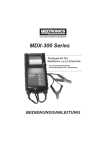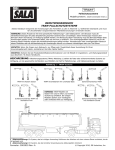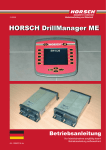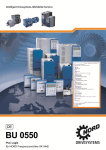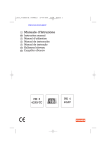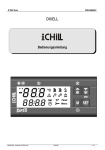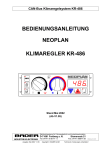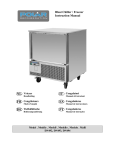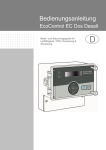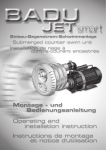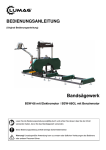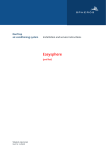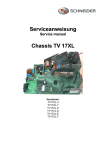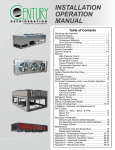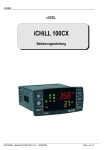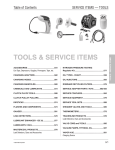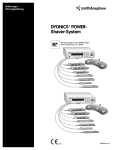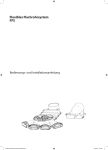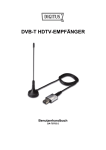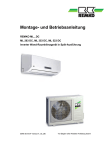Download Citysphere
Transcript
Aufdachklimaanlage Einbau- und Serviceanweisung Roof Top Air Conditioning System Installation and Service Instructions Climatisation sur toiture Instructions de montage et d’entretien Citysphere Stand: 12/2010 Ident-Nr. 11112716C Citysphere Inhaltsverzeichnis 1. EINLEITUNG 1 1.1.Bedeutung der Hervorhebungen 1 1.2.Zusätzlich anzuwendende Dokumente 1 1.3.Sicherheitshinweise und -bestimmungen 1 1.4.Zertifizierung 2 1.5.Verbesserungs- und Änderungsvorschläge 2 2. ALLGEMEINE BESCHREIBUNG 3 2.1.Komponenten 4 2.2.Elektrik 6 2.3.Funktionsweise der Klimaanlage 6 2.4.Aufbau, Aufgabe und Funktionsweise der Baugruppen 8 3. TECHNISCHE DATEN 10 3.1.Klimaanlage 10 3.2.Elektrische Sicherungen 11 3.3.Verdichter Bitzer ECH 209 11 3.4.Verbindungsschema 12 3.5.Schaltplan Master-Anlage 13 3.6.Schaltplan Slave-Anlage 14 4. EINBAU 15 4.1.Sicherheitshinweise 15 4.2.Voraussetzungen für Aufbau 15 4.3.Montagebausatz für Master-Anlage 15 4.4.Montagebausatz für Slave-Anlage 15 4.5.Nicht im Montagebausatz enthalten und selbst anzufertigen 15 4.6.Erforderliche Betriebsmittel, Sonderwerkzeug und Zubehör 16 4.7.Vorbereitende Maßnahmen am Fahrzeugdach 16 4.8.Aufkleben der Anlage 18 4.9.Elektrische Verbindungen herstellen 22 4.10.Luftverteiler montieren 24 4.11.Haube montieren 26 5. INBETRIEBNAHME 27 5.1.Sicherheitshinweise 27 5.2.Bedienerhinweise 27 5.3.Bedien- und Anzeigeelemente 27 I Citysphere 5.4.Erstinbetriebnahme 27 5.5.Zusatzfunktionen des Bedienteiles 28 6. INSTANDHALTUNG 6.1.Sicherheitshinweise 32 6.2.Allgemeines 32 6.3.Wartung und Pflege 32 6.4.Checkliste Wartung und Pflege 33 6.5.Prüfungen vor Instandsetzung 33 6.6.Fehlersuche und Maßnahmen zur Beseitigung 34 6.7.Instandsetzungsarbeiten 35 6.8.Prüfungen und Arbeiten nach Instandsetzung 35 7. GARANTIEABWICKLUNG II 32 37 Citysphere Contents 1. INTRODUCTION 39 1.1.Meaning of emphases 39 1.2.Additional applicable documentation 39 1.3.Safety information and regulations 39 1.4.Certification 40 1.5.Suggestions for corrections and improvements 40 2. GENERAL DESCRIPTION 41 2.1.Components 42 2.2.Electrical system 44 2.3.Principle of operation of the air conditioning system 44 2.4.Design, purpose and principle of operation of the assemblies 46 3. TECHNICAL DATA 48 3.1.Air conditioning system 48 3.2.Electrical fuses 49 3.3.Compressor Bitzer ECH 209 49 3.4.Connecting scheme 50 3.5.Circuit diagram master unit 51 3.6.Circuit diagram slave unit 52 4. INSTALLATION 53 4.1.Safety instructions 53 4.2.Conditions for assembly 53 4.3.Installation kit for master unit 53 4.4.Installation kit for slave unit 53 4.5.The following are not included in the installation kit and must be produced on site 53 4.6.Required equipment, special tools and accessories 54 4.7.Preparations on vehicle’s roof 54 4.8.Adhesive bonding of the unit 56 4.9.Establish electrical connections 60 4.10.Mount air-diffusor 62 4.11.Mount hood 64 5. STARTUP 65 5.1.Safety instructions 65 5.2.Operator instructions 65 5.3.Controls and indicators 65 III Citysphere 5.4.Putting into service for the first time 65 5.5.Additional control panel functions 66 6. MAINTENANCE IV 70 6.1.Safety instructions 70 6.2.General 70 6.3.Maintenance and Care 70 6.4.Maintenance and service checklist 71 6.5.Inspections before repair 71 6.6.Troubleshooting 72 6.7.Repairs 73 6.8.Post-repair procedures and testing 73 7. WARRANTY CLAIMS PROCESSING 75 Citysphere Sommaire 1. INTRODUCTION 77 1.1.Signification des signalisations 77 1.2.Autre documentation à utiliser 77 1.3.Instructions et prescriptions de sécurité 77 1.4.Certification 78 1.5.Suggestions d'amélioration ou de modification 78 2. DESCRIPTION GENERALE 79 2.1.Composantes 80 2.2.Système électrique 82 2.3.Mode de fonctionnement de la climatisation 82 2.4.Conception, fonction et mode de fonctionnement des sous-ensembles 84 3. DONNEES TECHNIQUES 86 3.1.Climatisation 86 3.2.Fusibles électriques 87 3.3.Compresseur Bitzer ECH 209 87 3.4.Schéma de raccordement 88 3.5.Schéma électrique Unité maître 89 3.6.Schéma électrique Unité esclave 90 4. MONTAGE 91 4.1.Consignes de sécurité 91 4.2.Conditions pour le montage 91 4.3.Kit de montage pour l'unité maître 91 4.4.Kit de montage pour l'unité esclave 91 4.5.Non compris dans le kit de montage et à réaliser soi-même 91 4.6.Matériel d'équipement nécessaire, outillage spécifique et accessoires 92 4.7.Préparation de la toiture du véhicule 92 4.8.Coller l'installation 94 4.9.Effectuer les raccordements électriques 98 4.10.Monter le répartiteur d'air 100 4.11.Monter le capot 102 5. MISE EN SERVICE 103 5.1.Consignes de sécurité 103 5.2.Instructions pour l'utilisateur 103 5.3.Eléments de commande et d'affichage 103 V Citysphere 5.4.Première mise en service 103 5.5.Autres fonctions de la commande 104 6. ENTRETIEN 6.1.Consignes de sécurité 108 6.2.Généralités 108 6.3.Maintenance et entretien 108 6.4.Check-list de maintenance et d'entretien 109 6.5.Contrôles avant réparation 109 6.6.Recherche des défauts et mesures pour leur élimination 110 6.7.Travaux de réparation 111 6.8.Contrôles et travaux après réparation 111 7. CONDITIONS DE GARANTIE VI 108 113 Aufdachklimaanlage Citysphere 1. EINLEITUNG Diese Einbau- und Serviceanweisung enthält zur Unterstützung von eingewiesenem Personal wichtige Informationen für Montage, Bedienung, Betrieb und Instandhaltung der Aufdachklimaanlage. 1.1. Bedeutung der Hervorhebungen In dieser Anleitung haben die Hervorhebungen VORSICHT, ACHTUNG und HINWEIS folgende Bedeutung: VORSICHT Diese Überschrift wird benutzt, wenn ungenaues Befolgen oder Nichtbefolgen von Anweisungen oder Verfahren zu Verletzungen oder tödlichen Unfällen führen kann. ACHTUNG Diese Überschrift wird benutzt, wenn ungenaues Befolgen oder Nichtbefolgen von Anweisungen oder Verfahren zur Beschädigung von Bauteilen führen kann. HINWEIS Diese Überschrift wird benutzt, wenn auf eine Besonderheit aufmerksam gemacht werden soll. 1.2. Zusätzlich anzuwendende Dokumente Betriebsanweisung Aufdachklimaanlage Citysphere 1.3. Sicherheitshinweise und -bestimmungen Die Aufdachklimaanlage wurde nach den EG-Richtlinien konstruiert und wird auch nach diesen produziert. Bei sachgerechter Montage und Nutzung, entsprechend der Einbau- und Serviceanweisung, ist die Anlage betriebssicher. Wird das in den Fahrzeugpapieren angegebene Höhenmaß durch den Einbau der Aufdachklimaanlage überschritten, so ist dies durch eine Abnahme nach § 19 StVZO zu legalisieren. Grundsätzlich sind die allgemeinen Unfallverhütungsvorschriften zu beachten. Über den Rahmen dieser Vorschriften hinausgehende „Allgemeine Sicherheitsbestimmungen“ sind nachfolgend aufgeführt. Die speziellen Sicherheitsbestimmungen sind in den einzelnen Abschnitten bzw. Verfahren in Form von Hervorhebungen angegeben. Allgemeine Sicherheitsbestimmungen Die Nichtbeachtung der Einbauanweisung und der darin enthaltenen Hinweise führen zum Haftungsausschluss seitens Spheros. Gleiches gilt für nicht fachmännisch oder nicht unter Verwendung von Originalersatzteilen durchgeführte Reparaturen. Elektrische Leitungen und Bedienelemente der Klimaanlage müssen im Fahrzeug so angeordnet sein, dass ihre einwandfreie Funktion unter normalen Betriebsbedingungen nicht beeinträchtigt werden kann. Seite 1 Aufdachklimaanlage Citysphere Sicherheitshinweise für Instandhaltungsarbeiten Treten Fehler im Kältemittelkreislauf auf, so muss die Anlage von einem Fachbetrieb geprüft und ordnungsgemäß instand gesetzt werden. Auf keinen Fall darf das Kältemittel in die freie Atmosphäre abgelassen werden. Kältemittelflaschen auf keinen Fall mit einer offenen Flamme erwärmen! Flüssiges Kältemittel darf nicht mit Körperteilen in Berührung kommen. Das Sicherheitsdatenblatt ist zu beachten. Beim Umgang mit Kältemittel Schutzbekleidung und eine Schutzbrille tragen. ACHTUNG Die Zuladung verringert sich um das Gewicht der zusätzlichen Einbauten. VORSICHT Keine Löt- oder Schweißarbeiten direkt an den Teilen des geschlossenen Kältekreislaufs oder in näherer Umgebung ausführen. Durch die starke Erwärmung steigt der Druck in der Anlage. Es besteht Explosionsgefahr. Vor Beginn von Arbeiten sollte die Anlage vollständig abgekühlt sein. Es besteht Verbrennungsgefahr am Verflüssiger, Verdichter, den Kältemittelrohren und dem elektrischen Heizer. Montage-, Wartungs- und Reparaturarbeiten sind von sachkundigem Personal durchzuführen. Sie dürfen nur bei stehendem Motor und ausgeschalteter Stromversorgung vorgenommen werden. Vor Arbeiten an der Elektrik ist die Batterie abzuklemmen. Beim Arbeiten an der Klimaanlage keinen Metallschmuck tragen (Armreifen, Uhren, Ketten, Ringe abnehmen). 1.4. Zertifizierung Die elektromagnetische Verträglichkeit wurde geprüft. Die Standards der ECE-Regelung R10 Rev. 03 werden erfüllt. 1.5. Verbesserungs- und Änderungsvorschläge Beanstandungen, Verbesserungen oder Vorschläge zur Berichtigung dieser Anweisung richten Sie bitte an: Spheros GmbH Friedrichshafener Straße 9 - 11 D-82205 Gilching Seite 2 Telefon: +49 (0) 8105 7721 887 Telefax: +49 (0) 8105 7721 889 Aufdachklimaanlage Citysphere 2. ALLGEMEINE BESCHREIBUNG Die Aufdachklimaanlage ist zur Kühlung/Klimatisierung und Heizung (nur Comfortversion) von Stadtbussen ausgelegt. Die Aufdachklimaanlage gibt es als Master- und als Slaveversion. Die Master-Anlage enthält alle zum Einbau und Betrieb notwendigen Dokumente und alle zum Betrieb der Anlage notwendigen Komponenten wie Steuergerät, Kabel Bedienteil (2), Bedienteil (3) und Temperatursensoren. Pro Fahrzeug muss immer eine Master-Anlage eingesetzt werden. Als Position für das Bedienteil bietet sich der Fahrerplatz und davon abhängend als Position für die Master-Anlage (1) die vordere an. Von der Master-Anlage können bis zu fünf Slave-Anlagen (5) mit Signalen für den Betrieb versorgt werden. Jede Slave-Anlage enthält deshalb ein Adapterkabel (6) mit dem die Verbindung zur davor platzierten Anlage hergestellt werden kann. Die elektrische Versorgung der Anlagen erfolgt über die Kabel (4, nicht im Lieferumfang) von der Fahrzeugversorgung aus. Die Anlagen sind für eine Betriebspannung von 24 V ausgelegt. Die Anlagen sind mit Kältemittel (R134a) befüllt und müssen bei der Montage nur an das Bordnetz angeschlossen werden. 5 5 6 1 6 4 2 4 4 1 2 3 4 Master-Anlage Kabel Bedienteil Bedienteil Kabel elektrische Versorgung 5 Slave-Anlage 6 Adapterkabel 3 Abb. 2.1 Seite 3 Aufdachklimaanlage Citysphere 2.1. Komponenten Die Aufdachklimaanlage ist in Abb. 2.3 dargestellt. 1 - Haube (äußeres Konturteil) 2 - Grundwanne, als tragendes Strukturteil 3 - Verflüssiger 4 - Verdichter 5 - Verflüssigergebläse 6 - Druckschalter 7 - Sammler/Trockner/Filter für Kältemittel 8 - Füllanschluss HD 9 - Füllanschluss ND 10 - Vereisungsschutzschalter 11 - Expansionsventil 12 - Verdampfer 13 - Luftfilter 14 - Verdampfergebläse 15 - Elektrischer Heizer (nur Comfortversion) 16 - Außentemperaturfühler (nur Master-Anlage) 17 - Elektroplatte (siehe Abb. 2.2) 18 - Luftverteiler 19 - Gitter 20 - Wasser-Ablauföffnungen 21 - Griffmulden bzw. Flächen für Hebevorrichtung b f c GL-W550 M8 15 Nm + d K1 g F5=60 A e 17a) Sicherungen 17b) Steuergerät (nur Master-Anlage) 17c) Elektrische Schnittstelle zum Bedienteil (nur Master-Anlage) 17d) Elektrische Schnittstelle zu weiteren Anlagen 17e) Relais für elektrische Heizung (nur Comfortversion) ¯ F1= 5 A F2=15 A F3=15 A F4= 5 A M10 20 Nm 17f) Sensor Innentemperaturfühler (nur Master-Anlage) 17g) Anschlussbolzen Spannungsversorgung a Abb. 2.2 Elektroplatte (vereinfacht) Seite 4 Aufdachklimaanlage Citysphere 5 13 12 1 2 16 10 3 6 4 7 9 20 8 11 21 17 15 14 18 19 Abb. 2.3 Seite 5 Aufdachklimaanlage Citysphere 2.2. Elektrik Einen Überblick über die Zusammenschaltung der einzelnen Module gibt das Schema in Abb. 3.1. Der elektrische Anschluß der Anlagen erfolgt gemäß Schaltplan in Abb. 3.2 bzw. in Abb. 3.3. Die Aufdachklimaeinheit ist mit einer Batterieentlade-Schutzeinrichtung ausgestattet. Erneute Inbetriebnahme erfolgt durch wiederholtes Einschalten. Ohne laufenden Fahrzeugmotor kann die Anlage nur in einer Lüftungsfunktion betrieben werden. Diese Funktion kann auch gesperrt werden (siehe Abschnitt 5.5.3). Die Elektronik des Verdichtermotors verfügt über einen Sanftanlauf zur Vermeidung von Stromspitzen auf das Bordnetz. Weiterhin wird der Elektromotor bei Überlastung (aufgrund eventueller Beschädigungen der Anlage) automatisch abgeschaltet. Erneute Inbetriebnahme erfolgt durch wiederholtes Einschalten der Anlage. 2.3. Funktionsweise der Klimaanlage Ab dem Einschalten der Anlage misst die Steuerung die Außentemperatur und die Innenraumtemperatur. Sobald folgende Bedingungen erfüllt sind, beginnt die Kühlfunktion der Anlage: – – – – Fahrzeugmotor läuft (Signal von D+/61) Außentemperatur größer als 17°C Innenraumtemperatur größer als 22°C Innenraumtemperatur größer als Außentemperatur minus Temperatursolldifferenz, TSD (angezeigter Wert auf dem Display des Bedienteiles) Frischluft Kaltluft Kaltluft Umluft * siehe Abb. 2.3 Abb. 2.4 Kühlbetrieb der Anlage Seite 6 Aufdachklimaanlage Citysphere Der Verdichter mit integriertem Elektromotor läuft an. Er komprimiert das Kältemittelgas und fördert es in den Verflüssiger, wo es unter Wärmeabgabe kondensiert. Die entstehende Kondensationswärme überträgt der Verflüssiger an die durch ihn strömende Außenluft. Dabei sorgt das Axialgebläse auch bei stehendem Fahrzeug für ausreichende Lüftung. Das flüssige Kältemittel strömt durch den Sammler-Trockner zum Expansionsventil, es entspannt durch geregelten Druckabfall und geht unter starker Wärmeaufnahme im Verdampfer wieder in den gasförmigen Zustand über. Die warme Umluft des Fahrgastinnenraumes wird vom Verdampfergebläse angesaugt, mit Frischluft vermischt, im Verdampfer gekühlt und getrocknet und dann über den Luftverteiler in den Fahrgastinnenraum zurückgefördert. Dabei entstehendes Kondenswasser wird abgeschieden und über die Ablauföffnungen nach außen geleitet. Im Betrieb wird der Kältekreislauf durch den Vereisungsschutzschalter und den Druckschalter überwacht. Diese beiden Schalter können den Verdichter abschalten (bei Bedarf). Beim Auftreten eines Fehlers an einer Anlage laufen die anderen Anlagen im normalen Betrieb weiter. Beim Ausschalten der Klimaanlage am Bedienteil werden die Gebläse und der Verdichter gestoppt, die Spannungsversorgung aller Komponenten bleibt jedoch erhalten. In die Aufdachanlage eindringendes Regenwasser wird über die Ablauföffnungen (20, Abb. 2.3) abgeleitet. Funktionsweise der Heizung (nur Comfortversion) Ab dem Einschalten der Anlage misst die Steuerung die Außentemperatur und die Innentemperatur. Sobald folgende Bedingungen erfüllt sind, beginnt die Heizfunktion der Anlage: – Fahrzeugmotor läuft (Signal von D+/61) – Außentemperatur kleiner als 17°C – Innenraumtemperatur zwischen 10°C und 22°C Frischluft Warmluft Warmluft Umluft * siehe Abb. 2.3 Abb. 2.5 Heizbetrieb der Anlage Seite 7 Aufdachklimaanlage Citysphere 2.4. Aufbau, Aufgabe und Funktionsweise der Baugruppen Verflüssiger Der Verflüssiger (3, Abb. 2.3) besteht aus Aluminium-Flachrohren und Aluminium-Lamellen, die zu einer großen Wärmetauscherfläche miteinander verbunden sind. Er kühlt das heiße Kältemittelgas so ab, dass es verflüssigt und unterkühlt, und er überträgt die Kondensationswärme über die Lamellen an die ihn durchströmende Außenluft. Sammler-Trockner Der Sammler-Trockner (7, Abb. 2.3) ist ein Ausgleichs- und Vorratsbehälter für Kältemittel. Er enthält im mittleren Bereich ein Trockner-Granulat, das dem Kältemittel geringe Mengen Wasser entzieht und chemisch bindet. Außerdem filtert er Schmutzpartikel aus dem Kältekreislauf, die ansonsten zu Störungen führen könnten. Thermostatisches Expansionsventil Das thermostatische Expansionsventil (11, Abb. 2.3) mit äußerem Druckausgleich reguliert den Kältemittelfluss zum Verdampfer, entsprechend dem Kältemittelbedarf bzw. der Temperatur im Verdampfer. Das thermostatische Expansionsventil ist das Regelelement zwischen Hoch- und Niederdruckteil des Kältemittelkreises. Verdampfer Der Verdampfer (12, Abb. 2.3) besteht aus Kupferrohren und Aluminiumlamellen die zu einer großen Wärmetauscherfläche miteinander verbunden sind. Um den zur Verfügung stehenden Bauraum optimal auszunutzen ist der Verdampfer U-förmig gebogen. In ihm geht das vom Expansionsventil durch die Rohrleitung strömende Kältemittel vom flüssigen in den gasförmigen Zustand über und wird überhitzt. Die dazu erforderliche Verdampfungswärme wird über die Lamellen der durchströmenden Luft entzogen und über die Rohrwandung auf das Kältemittel übertragen. Dabei wird die erkaltende Luft getrocknet und entstehendes Kondenswasser nach außen abgeleitet. Druckschalter Der Druckschalter (6, Abb. 2.3) enthält einen Hoch- und Niederdruckschalter. Er misst den Druck im Hochdruckteil des Kältemittelkreises und schaltet bei zu geringem Druck (durch Kältemittelmangel) oder zu hohem Druck (z. B. durch Überhitzung des Verflüssigers) den E-Motor und somit den Verdichter aus. Vereisungsschutzschalter Der Vereisungsschutzschalter (10, Abb. 2.3) ist ein Temperaturschalter. Er misst die Temperatur des Kältemittels an den Einspritzrohren des Verdampfers und schaltet bei Vereisungsgefahr und bei Kältemittelmangel den Verdichter ab. Verflüssigergebläse Das Verflüssigergebläse (5, Abb. 2.3) besteht aus einem bürstenlosen EC-Motor, Lüfterrad, Gehäuse und Schutzgitter. Sobald die Kühlfunktion aktiv ist, wird das Gebläse über Pin 3 (gelbe Leitung) von der Regelung aktiviert und versorgt den Verflüssiger mit der erforderlichen Außenluft (keine Drehzahlregelung - nur Ein/Aus). Verdampfergebläse Das Verdampfergebläse (14, Abb. 2.3) besteht aus einem bürstenlosen EC-Motor und dem Lüfterrad. Es saugt Luft aus dem Innenraum und Frischluft durch den Verdampfer und den elektrischen Heizer (nur Comfortversion) und bläst sie durch den Luftverteiler in den Innenraum zurück. Die Drehzahl des Gebläses wird über Pin 3 (gelbe Leitung) von der Regelung vorgegeben (PWM-Signal). Die Wahl der Gebläsedrehzahl erfolgt automatisch oder auf Wunsch manuell. Seite 8 Aufdachklimaanlage Citysphere Verdichter Der Verdichter (4, Abb. 2.3) besteht aus einem halbhermetischen Gehäuse mit integriertem Scrollverdichter, bürstenlosen EC-Motor und Elektronik. Sobald die Kühlfunktion aktiv ist, wird der Verdichter über Pin 1 des Verdichterkabels aktiviert und mit dem erforderlichen Drehzahlsignal angesteuert (PWM-Signal). Dabei verdichtet er das Kältemittel auf den zur Verflüssigung erforderlichen Druck. Der integrierte Elektromotor verfügt über einen Sanftanlauf zur Vermeidung von Stromspitzen auf das Bordnetz, einer Spannungsüberwachung (21 V bis 31 V), einen Überlastschutz und eine Temperaturüberwachung der Elektronik (+5°C bis 96°C). Außerhalb der Grenzen wird der Verdichter abgeschaltet. Erneute Inbetriebnahme erfolgt durch wiederholtes Einschalten der Anlage. HINWEIS Die Funktion des Verdichters ist gesperrt, wenn an Pin 4 des VerdichterKabels keine Bordspannung anliegt (Sicherheitskette Druckschalter und Vereisungssensor). Seite 9 Aufdachklimaanlage Citysphere 3. TECHNISCHE DATEN 3.1. Klimaanlage Benennung Citysphere Abmessungen (Aufdachklimaeinheit) Länge x Breite x Höhe 1200 mm x 860 mm x 250 mm Gewicht ca. 55 kg Betriebsspannung (entspr. Fahrzeug-Bordnetz) 24 VDC Stromaufnahme Gesamte Stromaufnahme 72 A (max.) – Verdichtermotor – Verflüssigergebläse – Verdichtergebläse 55 A 10 A 7A Schaltpunkte Niederdruckschalter – Ein – Aus 2,1 ± 0,3 bar 2,0 ± 0,2 bar Schaltpunkte Hochdruckschalter – Aus – Ein 26,5 ± 2 bar 20 ± 2 bar Nennleistung bei Innentemperatur 25°C, Außentemperatur 29°C 3,8 kW Verdampfergebläse – Luftvolumenstrom (frei blasend) 1350 m3/h Schaltpunkt Vereisungsschalter – – Aus Ein 1°C ± 1 3,5°C (Max) Kältemittel R134a, 800g (bereits vorbefüllt) Heizleistung (nur Comfortversion) ca. 1 kW Seite 10 Aufdachklimaanlage Citysphere 3.2. Elektrische Sicherungen Abgesicherte Bauteile Sicherung Kurzzeichen Sicherungswert F1 5A Verdampfergebläse F2 15 A Verflüssigergebläse F3 15 A Relais für elektrische Heizung (nur Comfortversion) F4 5A Verdichter und falls vorhanden elektrische Heizung F5 60 A Druckschalter, Vereisungsschutzschalter, digitaler Eingang Verdichter 3.3. Verdichter Bitzer ECH 209 Kältemaschinenöl (Typ / Menge) BSE55 / 120 ml Drehzahl (Ansteuerung über PWM-Signal) 1200 bis 2100 U/min Seite 11 Control Panel Seite 12 Wire Harness Abb. 3.1 Wago 4pol. Ident No. 2710687 Master Wago 7pol. Wago 7pol. Wago 7pol. Adapter Cable Ident No. 2710699 Adapter Cable Ident No. 2710699 Up to max. 6 Units Adapter Cable Slave Ident No. 2710699 Slave 3.4. Ident No. 2710688 Aufdachklimaanlage Citysphere Verbindungsschema Positive terminal bolt Electric plate G1+ Ground terminal bolt Electric plate G2- GL-W560 GL-W550 Control Unit Compressor Motor 3.5. Control Panel Aufdachklimaanlage Citysphere Schaltplan Master-Anlage Abb. 3.2 Seite 13 Abb. 3.3 Seite 14 Positive terminal bolt Electric plate G1+ 3.6. Ground terminal bolt Electric plate G2- Compressor Motor Aufdachklimaanlage Citysphere Schaltplan Slave-Anlage Aufdachklimaanlage Citysphere 4. EINBAU 4.1. Sicherheitshinweise Die Sicherheitshinweise gemäß Abschnitt 1.3 sind vor Beginn der Arbeiten zu lesen und zu beachten. Der Einbau soll durch Personen erfolgen, die auf dem Gebiet der Kraftfahrzeugtechnik/Kraftfahrzeugelektrik sachkundig sind. 4.2. Voraussetzungen für Aufbau – Vor Aufbau und Betrieb der Klimaanlage(n) muss die Stromversorgung des Fahrzeugs auf ausreichende Kapazität überprüft und gegebenenfalls erweitert werden. Je aufzubauender Anlage muss eine freie Generatorkapazität von 72 A (max. Stromaufnahme pro Anlage) zur Verfügung stehen. Diese Kapazität muss auch bei Leerlaufdrehzahl und gleichzeitig maximaler Motorraumtemperatur sichergestellt sein (Niedrige Drehzahl und hohe Umgebungstemperatur mindern die Leistungsabgabe der Generatoren). – Vorhandener Lukenausschnitt je aufzubauender Anlage 530/564 x 970 mm. – Die gemäß der Betriebserlaubnis erforderliche Anzahl von Notausstiegsluken darf durch die aufzubauenden Anlagen nicht verringert werden. 4.3. – – – – Aufdachklimaeinheit Master Luftverteiler Befestigungssatz Bedienteil + Kabel 4.4. – – – – Montagebausatz für Master-Anlage Montagebausatz für Slave-Anlage Aufdachklimaeinheit Slave Luftverteiler Befestigungssatz Adapterkabel zur vorhergehenden Anlage (Master oder Slave) 4.5. Nicht im Montagebausatz enthalten und selbst anzufertigen – – – – – – Elektrische Anschlusskabel und Elemente (fahrzeugseitig) Befestigungselemente zum Verlegen der Anschlusskabel Sicherungshalter und Sicherungen zur Absicherung der elektrischen Anschlusskabel Sicherungshalter und Sicherung zum Anschluss des Bedienteiles an Klemme 15 Kleber (Sika 252), Reiniger (Sika-Cleaner 205), Aktivator (Sika-Primer 215), Schleifpapier Schaumstoff zur Abdichtung des Luftspaltes zwischen Dach und Innendecke, umlaufend der Anlage (Vermeidung Luftkurzschluss) mit folgender Qualifikation: – geschlossenzellig – geringe Wasseraufnahme – Brandverhalten nach FMVSS 302 bzw. 95/28/EG Anhang IV Zum Beispiel: D2600 von Cellofoam – Eventuell notwendige zusätzliche Generatoren mit Montagekit Seite 15 Aufdachklimaanlage Citysphere 4.6. Erforderliche Betriebsmittel, Sonderwerkzeug und Zubehör a) Aufbau auf bestehenden Lukenausschnitt – Schwingsäge zum Entfernen des bestehenden Lukenrahmens – Silikonspray zum Schmieren des Sägeblattes b) Für Service (Evakuierung, Befüllung und Prüfung des Kältemittelkreislaufs) – – – – – – – – 4.7. Service-Recyclingstation für Kältemittel R134a Vakuumpumpe, Saugleistung min. 5 m3/h, Enddruck 1 mbar Füllschläuche mit Schnellverschlussstutzen für R134a Lecksuchgerät Digitalthermometer Kältemittel R134a Kältemaschinenöl BSE55 Prüfarmaturen mit Saugdruck- und Hochdruckmanometern Vorbereitende Maßnahmen am Fahrzeugdach – Der Einbau ist vom Fahrzeugtyp abhängig, deshalb sind Vorgaben des Fahrzeugherstellers zu beachten. Aufbau auf bestehenden Lukenausschnitt – Deckeninnenverkleidung entfernen. Abb. 4.1 Seite 16 Aufdachklimaanlage Citysphere – Dachlukenrahmen mit Schwingsäge entfernen. Dazu den Kleber horizontal und vertikal durchtrennen (Sägeblatt mit Silikonspray schmieren). Abb. 4.2 Abb. 4.3 ACHTUNG Keine tragenden Teile (z. B. Spriegel, Versteifungen) oder Einbauten beschädigen. Seite 17 Aufdachklimaanlage Citysphere – Klebereste entfernen und neue Klebefläche reinigen. Abb. 4.4 4.8. Aufkleben der Anlage Die erste Anlage in Fahrtrichtung vorn sollte die Master-Anlage (erkennbar an Steuergerät und Temperaturfühler) sein. Verflüssiger zeigt in Fahrtrichtung. Die weiteren Anlagen sind Slave-Anlagen und werden von der Master-Anlage gesteuert. – Anlage aufsetzen, ausmitteln und anzeichnen. Abb. 4.5 HINWEIS Der Radius des Lukenausschnittes passt nicht zwingend mit der Kontur der Klebefläche der Grundwanne zusammen. Deshalb ist es zweckmäßig, die Innenkontur der Grundwanne auf das Busdach zu übertragen. Seite 18 Aufdachklimaanlage Citysphere 1010 R55 R100 (970) 604 (564) Fahrtrichtung Lukenausschnitt 970x564, R80 20 20 (R80) Mitte Klebenaht 20 bei 970x564 37 bei 970x530 Abb. 4.6 Auf gleichmäßigen Abstand der Halter zum Dach achten. Abb. 4.7 Seite 19 Aufdachklimaanlage Citysphere – Grundwanne und Dachhaut im Klebebereich aufrauhen analog der Klebenaht (Abb. 4.6 und 4.10), mit Sika-Cleaner reinigen und mit Sika-Primer vorbehandeln (Produkthinweise beachten). Abb. 4.8 Abb. 4.9 Seite 20 Aufdachklimaanlage Citysphere – Sika-Raupe auf die Dachhaut auftragen und Anlage aufsetzen. Der Klebespalt ergibt sich durch Abstands-Beulen in der Klebefläche der Grundwanne. Abb. 4.10 – Von der Businnenseite aus ringsum prüfen, ob alles richtig abgedichtet ist. Abb. 4.11 – Hintere und mittlere Halter mit Sika fixieren und mit Innensechskantschraube am oberen Gegenhalter festschrauben. Vordere Halter mit Gewindestange und Kontermuttern am Gewindebolzen befestigen. Klebeverbindung während des Aushärtens des Klebers nicht beanspruchen! hinterer Halter mittlerer Halter vorderer Halter Abb. 4.12 Seite 21 Aufdachklimaanlage Citysphere 4.9. Elektrische Verbindungen herstellen Die Anlage ist fahrzeugseitig mit maximal 100 A direkt nach der Batterie abzusichern. Der Kabelquerschnitt ist folgendermaßen festzulegen: Mindestquerschnitt 25 mm2, ab einer Kabellänge (einfache Länge) von 19 m ist ein Querschnitt von 35 mm2 zu verwenden und ab einer Länge von 26 m bis zu 38 m ist ein Querschnitt von 50 mm2 zu verwenden. Siehe auch „Elektrische Kupferleitungen für Kraftfahrzeuge“ DIN VDE 0298-Teil 4. a) Fahrzeugbatterie abklemmen. ACHTUNG Zum Anschluss der Stromversorgung für die Klimaanlage sind die Vorgaben des Fahrzeugherstellers zu beachten. Es sind nur für den Einbau in Kfz zugelassene Kabel mit ausreichendem Querschnitt zu verwenden. Die Elektroarbeiten sind von einer dazu autorisierten Person auszuführen. Zum Verlegen der Kabel durch Bleche geeignete Kabeltüllen / Kantenschutz verwenden. b) Kabelverbindungen zwischen Fahrzeugbatterie und Anlagen herstellen. – Kabel in Schutzhüllen verlegen und mit Kabelbindern ausreichend befestigen. – Die Stromversorgung der Anlage ist an den dafür vorgesehenen Kabelbolzen an der Elektroanschlußplatte anzuschließen (Abb. 2.2). ACHTUNG Dabei ist unbedingt auf die richtige Polarität zu achten! (+Pol: M8 Kabelbolzen, -Pol: M10 Kabelbolzen). Ein Vertauschen der Polarität zerstört das Steuergerät! – Zugentlastungen vorsehen. c) Kabelverbindung zwischen Bedienteil und Master-Anlage mit dem beiliegenden Kabelbaum herstellen. – Bedienteil an geeigneter Stelle montieren und Kabelbaum anstecken. 57 40 45 40 21 52 24 29 35 Abb. 4.13 Seite 22 Aufdachklimaanlage Citysphere Abb. 4.14 Abb. 4.15 – Kabelbaum mit Klemme 15 und D+ (Klemme 61) verbinden (bei Klemme 15 Sicherungshalter und Sicherung 5 A zwischenschalten). – Kabel in Schutzhüllen verlegen und mit Kabelbindern ausreichend befestigen. – Kabel gemäß Farbcodierung an den 4-poligen Klemmverbinder der Master-Anlage anschließen. d) Beiliegenden Innenraumsensor an der Elektroplatte befestigen und anstecken. e) Kabelverbindung zwischen Master-Anlage und Slave-Anlage oder zwischen Slave-Anlage und einer weiteren Slave-Anlage herstellen. – Beiliegende Adapterkabel entsprechend der Nummerierung an den 7-poligen Klemmverbinder der beiden Anlagen anschließen. – Kabel in Schutzhüllen verlegen und mit Kabelbindern ausreichend befestigen. Seite 23 Aufdachklimaanlage Citysphere 4.10. Luftverteiler montieren – Zuerst die vorderen Gewindestangen einstellen und kontern. Danach die restlichen Gewindestangen auf die gleiche Höhe einstellen und kontern. 20 Nm* 20 Nm* 66 Innenverkleidung * Achtung: Beim Festziehen an der oberen Mutter gegenhalten. Abb. 4.16 – Innenverkleidung ausschneiden, Abstand zu den Gewindestangen ca. 20-30 mm (820x530). Abb. 4.17 Seite 24 Aufdachklimaanlage Citysphere – Schaumstoff rundum zwischen Dach und Deckeninnenverkleidung einbringen, um zu vermeiden, dass Luft aus dem Deckenbereich angesaugt wird. Abb. 4.18 – Hut auf dem Luftverteiler ausrichten und festnieten. – Luftverteiler montieren. Darauf achten, dass er mit der Innenverkleidung des Daches fluchtet und dass der Hut umlaufend an der Dichtung der Grundwanne anliegt. – Befestigung des Luftverteilers bei den mittleren Gewindestangen mit Muttern M8 und an den anderen Gewindestangen mit den Adaptern M6/M8 (siehe Abb. 2.3). Abb. 4.19 Seite 25 Aufdachklimaanlage Citysphere – Gebläsestecker verbinden und mit Kabelband gegen Scheuern sichern. – Luftansauggitter befestigen. Abb. 4.20 4.11. Haube montieren – Luftfilter auf richtigen Sitz kontrollieren. Luftfilter Abb. 4.21 – Nach Aufsetzen der Haube das Verflüssigergebläse anstecken. Das Kabel möglichst weit auf die in Fahrtrichtung gesehen rechte Seite ziehen. Das Gebläsekabel mit dem Kabelclip an der Trennwand rechts befestigen, um während des Betriebes eine Kollision des Kabels mit dem Laufrad des Gebläses zu vermeiden. – Das Verflüssigergebläse und das Gitter einsetzen und die 4 Schrauben ansetzen. Danach die Haube mit den 7 Flachkopfschrauben befestigen. Abschließend alle Schrauben festziehen. – Gebläse: 4 Nm (Torx30) – Haube : 3 Nm (Schlitz) Seite 26 Aufdachklimaanlage Citysphere 5. INBETRIEBNAHME 5.1. Sicherheitshinweise Die Sicherheitshinweise gemäß Kap. 1.3 sind zu beachten. VORSICHT Inbetriebnahme der Anlage nur mit montierter Haube und montiertem Luftverteiler. Verletzungsgefahr durch die Gebläse. 5.2. Bedienerhinweise ACHTUNG Die Klimaanlage kann nur bei laufendem Fahrzeugmotor in Betrieb genommen werden. 5.3. Bedien- und Anzeigeelemente 4 7 1 6 2 3 1 2 3 4 5 6 7 Gebläse Aussentemperatur Ein/ Aus Anzeigefeld Punkt Abwärts Aufwärts 5 Abb. 5.1 5.4. Erstinbetriebnahme a) Zündung am Fahrzeug einschalten und dabei das Bedienteil beobachten. Im Anzeigefeld muss für ca. 1 Sekunde die Anzeige und anschließend die aktuelle Versionsnummer des Bedienteils erscheinen. Nach ca. 3 Sekunden erlischt die Anzeige und ein blinkender Punkt rechts unten im Anzeigefeld signalisiert die Bereitschaft des Systems. b) Fahrzeugmotor nach Herstellerangaben starten. c) Anlage über Taste 3 einschalten. Je nach Außentemperatur und Temperatur im Fahrgastraum ist die Anlage im Kühl-, Heiz- oder Lüftungsbetrieb (Heizbetrieb nur bei Comfortversion). Seite 27 Aufdachklimaanlage Citysphere 5.5. Zusatzfunktionen des Bedienteiles Um alle Funktionen der Anlage unabhängig von den Temperaturen prüfen zu können gibt es einen Testmodus und einen Visualisierungsmodus. Für eine individuelle Konfiguration des Bedienteiles gibt es einen Parametermodus. 5.5.1. Testmodus HINWEIS Um die Fahrzeugbatterien nicht zu belasten sollte der Testmodus nur bei laufendem Fahrzeugmotor betrieben werden. Der Betrieb ohne Fahrzeugmotor ist nur zum Prüfen der Gebläse empfehlenswert. Bei Außentemperaturen unter 17°C darf die Anlage nur eingeschränkt im Kühlbetrieb laufen: Temperatur Beschreibung Unter 5°C Kein Kühlbetrieb zulässig Zwischen 5°C und 12°C Maximale Betriebsdauer 3 Minuten Zwischen 13°C und 17°C Maximale Betriebsdauer 15 Minuten ACHTUNG Nichtbeachtung kann eine Beschädigung des Verdichters zur Folge haben. Bedienung Um in den Testmodus zu gelangen, muss die Taste für einige Sekunden gedrückt werden, bis das Display anzeigt. Das Passwort um Zugang zum Testmodus zu erhalten lautet . Die Eingabe des Passwortes erfolgt über die Tasten und . Mit der Taste wird das Passwort bestätigt. Ist die Passworteingabe nicht korrekt erscheint wieder die Temperatur-Soll-Differenz. Bei korrekter Eingabe kann mit den Tasten und zwischen Ausgängen und Eingängen gewechselt werden, durch Bestätigen mit gelangt man in das entsprechende Menü. Um den Testmodus zu verlassen, muss die Taste Eingangs/Ausgangs erfolgt mit den Tasten und Seite 28 gedrückt werden. Die Auswahl des gewünschten und wird mit der Taste bestätigt. Aufdachklimaanlage Citysphere Ausgänge Parameter Beschreibung Das Verdampfergebläse läuft mit 25% Leistung und kann über die Tasten verändert werden. und Der Verdichter, das Verdampfergebläse und das Verflüssigergebläse laufen auf Maximalstufe. Das Verdampfergebläse kann über die Tasten und verändert werden. Achtung: bei Betrieb ohne Fahrzeugmotor kann die Fahrzeugbatterie sehr schnell entladen werden Achtung: Bei Außentemperaturen unter 17°C ist dieser Modus nur für eine Betriebsdauer gemäß obenstehender Tabelle zulässig. Das Verflüssigergebläse läuft auf Maximalstufe Das elektrische Heizelement ist eingeschaltet und das Verdampfergebläse läuft mit Heizungsdrehzahl. Das Verdampfergebläse kann über die Tasten und verändert werden. Achtung: Bei Betrieb ohne Fahrzeugmotor kann die Fahrzeugbatterie sehr schnell entladen werden. Ein blinkender Punkt rechts unten im Anzeigefeld bedeutet, dass der gewählte Ausgabemodus ausgeschaltet ist. Ein dauerhaft leuchtender Punkt bedeutet, dass der Ausgang eingeschaltet ist. Um die Ausgänge ein/auszuschalten muss die Taste oder die Taste gedrückt werden. Eingänge Parameter Beschreibung Zustand Punkt Bedeutung 0V Blinken Fehler Z oder 24 V Ein OK Z oder 0 V Blinken Kein elektr. Heizer vorh. 24 V Ein Elektr. Heizer vorhanden Z oder 0 V Blinken Fehler 24 V Ein OK 24 V Blinken Fehler Z oder 0 V Ein OK 24 V Blinken Fehler Z oder 0 V Ein OK Diagnoseausgang Verdichtermotor Automatische Erkennung des elektr. Heizelementes (bei montiertem Relais) D + (Klemme 15) Verflüssigergebläse Verdampfergebläse Z bedeutet hochohmig Seite 29 Aufdachklimaanlage Citysphere 5.5.2. Visualisierungsmodus In den Visualisierungsmodus gelangt man durch zeitgleiches Drücken der Tasten und für einige Sekunden. Mit den Tasten und kann der gewünschte Betriebzustand angewählt werden, dessen Wert durch Bestätigen mit der Taste angezeigt wird. Mit der Taste gelangt man zurück zur Betriebzustandsauswahl, durch erneutes Drücken kann der Visualisierungsmodus verlassen werden. Betriebszustand Beschreibung Fahrgastraumtemperatur Aussentemperatur Bordspannung [V] PWM [%] Verdampfergebläse PWM [%] Kompressor Software Version Bedienteil Software Version Steuergerät Regler Teilberechnung (Proportionalanteil) Regler Teilberechnung (Integralanteil) Temperatur Sollwert Stundenzähler Verdichter* Stundenzähler el. Heizelement* (nur bei Comfortversion) Stundenzähler gesamte Anlage* D+ (Klemme 61) Spannung [V] * Für die Stundenzähler werden die Betriebszeiten in drei aufeinanderfolgenden blinkenden Zahlenwerten angezeigt. z.B. zeigt das Display nach Wahl von Parameter die Zahlenwerte . Dies bedeutet, dass der Verdichter insgesamt für 129112 Stunden gelaufen ist. Seite 30 Aufdachklimaanlage Citysphere 5.5.3. Parametermodus Um in den Parametermodus zu gelangen muss die Taste für einige Sekunden gedrückt werden, bis das Display anzeigt. Das Passwort um Zugang zu den Parametern zu erhalten lautet . Die Eingabe des Passwortes erfolgt über die Tasten und . Mit der Taste wird das Passwort bestätigt. Ist die Passworteingabe nicht korrekt, erscheint wieder die Temperatur-Soll-Differenz. Um den Parametermodus zu verlassen, muss die Taste gewünschten Parameters erfolgt mit den Tasten und Parameter Beschreibung Zeit, die das Verdampfergebläse ohne D+ (Klemme 61) Signal arbeitet gedrückt werden. Die Auswahl des und wird mit der Taste bestätigt. Voreinstellung Max Min 30 min 90 min 0 min 1 2 0 0 1 0 25% 40% 10% 1 1 0 Auswahl der Temperatur-Soll-Differenz (TSD)-Funktion: 0: TSD wird fest auf den aktuellen Wert festgelegt und kann im Normalbetrieb nicht verändert werden 1: TSD kann im Normalbetrieb verändert werden 2: TSD wird auf einen Wert von 3 fest eingestellt und kann im Normalbetrieb nicht verändert werden Autostart 0: Aus 1:Ein Leistungsstufe Verdampfergebläse im Heizmodus Manuelle Verstellung des Verdampfergebläses 0: Gesperrt 1: Freigegeben Seite 31 Aufdachklimaanlage Citysphere 6. INSTANDHALTUNG 6.1. Sicherheitshinweise Die Sicherheitshinweise und –vorschriften gemäß Abschnitt 1.3 sind zu beachten. 6.2. Allgemeines a) Alle Arbeiten am Kältemittelkreislauf sind nur von sachkundigem Personal autorisierter Fachwerkstätten auszuführen. b) Zu Instandhaltungsarbeiten am Klimakreislauf sind die in Kapitel 4.6 aufgeführten speziellen Betriebsmittel, Sonderwerkzeuge sowie Zubehörteile erforderlich und einzusetzen. c) Wie alle Teile eines Fahrzeuges ist auch die Klimaanlage einer ständigen Belastung ausgesetzt. Um einen einwandfreien Betrieb der Anlage zu gewährleisten und um Beschädigungen von Teilen zu vermeiden, müssen regelmäßig die vorgeschriebenen Wartungsarbeiten durchgeführt werden. d) Die richtige Behandlung der Anlage mit Nachweis über die Durchführung aller vorgeschriebenen Wartungsarbeiten sind Voraussetzung für die Anerkennung eventueller Gewährleistungsansprüche bei Schäden an Teilen, die der Wartung unterliegen. e) Um das Festsetzen beweglicher Teile innerhalb des Kältemittel-Kreislaufes infolge Ölverharzung zu vermeiden, ist bei Betriebspausen mindestens einmal im Monat die Klimaanlage für einen Zeitraum von ca. 10 Minuten einzuschalten. Voraussetzung: (Mindest-Außentemperatur > 12°C oder beheizte Halle) 6.3. Wartung und Pflege a) Unabhängig von nachfolgendem Zeitplan sind innerhalb der ersten 4 Wochen nach erstmaliger Inbetriebnahme der Aufdachklimaanlage alle Gerätebefestigungen auf festen Sitz zu prüfen. b) Auch wenn die Klimaanlage nicht betrieben wird, kann ein Verschleiß von einzelnen Komponenten durch normale Alterung oder Beanspruchung durch den Fahrbetrieb auftreten. Daher sind die im Wartungs- und Serviceplan aufgeführten Kontrollen unabhängig von der Betriebszeit der Anlage durchzuführen. c) Unabhängig von der Betriebszeit der Anlage ist auch ein Verlust an Kältemittel trotz dichter Leitungsanschlüsse möglich. Bei relativ großem Kältemittelverlust kann jedoch eine Undichtigkeit in der Anlage angenommen werden. d) Das Reinigen der Verflüssiger- oder Verdampferlamellen erfolgt bei geringer Verschmutzung mit Pressluft gegen die normale Luftströmungsrichtung. Bei starker Verschmutzung oder fettigem Belag ist erst mit Seifenlauge oder geeigneter Reinigungslösung (nicht aggressiv gegen Kupfer oder Aluminium) zu reinigen und mit Pressluft oder Wasserstrahl nachzubehandeln. e) Bei Arbeiten am Kältemittelkreislauf ist der Sammler-Trockner grundsätzlich zu wechseln. f) Die Filtermatte ist regelmäßig zu erneuern. g) Die Ablauföffnungen für Regenwasser in der Grundwanne sind freizuhalten. ACHTUNG Das Kältemittel darf nie in die freie Atmosphäre abgelassen werden. Seite 32 Aufdachklimaanlage Citysphere 6.4. Checkliste Wartung und Pflege Anlagenteil Wartungsarbeiten Häufigkeit m 6m a Kältemittelkreislauf – – – – Anschlüsse Verflüssiger Kondenswasserablauf Aufdachklimaeinheit Dichtigkeitsprüfung mit Lecksuchgerät durchführen Lamellen auf Zustand prüfen (bei Verschmutzung reinigen) Öffnungen prüfen und ggf. reinigen Gesamtzustand und Anschlußstellen auf festen Sitz prüfen X X X X Verdichter – Verdichter Auf abnormale Geräusche während des Laufes prüfen – Befestigungselemente Auf Zustand und Funktion prüfen – elektr. Anschlüsse Auf Oxidation prüfen X X X Elektr. Anschlüsse – Anschlussleitungen – Steckverbindungen Auf einwandfreien Zustand prüfen Auf einwandfreien Zustand und festen Sitz prüfen X X Legende: m - monatlich, a – jährlich (6m – bei ganzjährigem Betrieb halbjährlich durchführen) 6.5. Prüfungen vor Instandsetzung Zur Vermeidung von unnötigen Demontage- bzw. Doppelarbeiten ist die Klimaanlage vor Beginn von Instandsetzungsarbeiten auf Gesamtzustand zu prüfen. Sichtprüfung a) Äußerer Zustand Aufdachklimaeinheit: – – – – – b) Haube keine Risse, Lackschäden Luftein- und -auslässe sauber und unbeschädigt Befestigungspunkte auf festen Sitz, keine Korrosion Kabelanschlüsse einwandfrei Blechdurchführungen einwandfrei. Luftverteiler auf Zustand – Befestigungspunkte/-schrauben auf festen Sitz – Umluftansauggitter unbeschädigt, sauber. c) Verdichter auf Zustand – Rohranschlüsse unbeschädigt, fester Sitz – Befestigungselemente/-schrauben auf festen Sitz – Elektrischer Anschluss unbeschädigt. Seite 33 Aufdachklimaanlage Citysphere 6.6. Fehlersuche und Maßnahmen zur Beseitigung 6.6.1. Allgemeines a) Bei der Fehlersuche und deren Beseitigung ist eine systematische Vorgehensweise zweckmäßig. Entsprechende Maßnahmen bei Störungen allgemeiner Art oder Abweichungen von Sollzuständen bei der Druckprüfung sind wie unten beschrieben durchzuführen. b) Bestimmte Fehler können nur durch sachkundiges Personal mit Spezialwerkzeug festgestellt und behoben werden. 6.6.2. Ursachen bei Störungen an der Elektrik Hierbei sind systematisch die einzelnen Stromkreise anhand des Schaltplans (siehe Abb. 3.2) zu überprüfen und der Fehler einzukreisen. Vorzugsweise sind dabei die Steckanschlüsse, Schalter, Relais etc. auf Durchgang zu überprüfen. Folgende Störungsursachen sollten grundsätzlich geprüft bzw. eine Störung aus diesem Grunde ausgeschlossen werden: – – – – – – Defekte Sicherungen Korrosion an Steckerkontakten Wackelkontakt an Steckern Crimpfehler an Steckern Korrosion an Leitungen und Sicherungen Korrosion an Batteriepolen 6.6.3. Ursachen bei Störungen im Klimasystem – defektes Verdampfer- oder Verflüssigergebläse – verschmutzter oder verstopfter Luftfilter, verschmutzte Verflüssiger- oder Verdampferlamellen – zu geringe Kältemittelmenge in der Anlage Erfolgt eine kontinuierliche Abschaltung, empfehlen wir, die Anlage von einem autorisierten Fachbetrieb prüfen zu lassen. 6.6.4. Maßnahmen bei Störungen im Kältemittelkreislauf Treten Fehler im Kältemittelkreislauf auf, so muss die Anlage von einem autorisierten Fachbetrieb geprüft und ordnungsgemäß instand gesetzt werden. Auf keinen Fall darf das Kältemittel in die freie Atmosphäre abgelassen werden. 6.6.5. Ursachen, wenn Sollzustände während der Druckprüfung nicht erreicht werden Werden bei der Druckprüfung (Kap. 6.8) Abweichungen zum Sollzustand festgestellt, können folgende Ursachen dazu geführt haben. Diese Ursachen prüfen, lokalisieren, defekte Teile ggf. instand setzen oder austauschen. Druck am Hochdruckmanometer zu hoch – zu geringer Luftdurchsatz am Verflüssiger – Kältemittelmenge zu hoch Druck am Hochdruckmanometer zu gering – Kältemittelmenge zu gering – Verdichterdrehzahl zu niedrig (Anlage im Regelbetrieb, Maximaldrehzahl kann im Testmodus (5.5.1) erzwungen werden) – Verdichter defekt Seite 34 Aufdachklimaanlage Citysphere Druck am Niederdruckmanometer zu hoch – Expansionsventil fehlerhaft – Verdichterdrehzahl zu niedrig – Verdichter defekt Druck am Niederdruckmanometer zu gering – – – – – Drosselung in der Saug- oder Druckleitung z.B. durch Leitungsknicke Expansionsventil fehlerhaft Kältemittelmenge zu gering zu geringer Luftdurchsatz am Verdampfer Sammler-Trockner verstopft 6.7. Instandsetzungsarbeiten ACHTUNG Kältemittel darf nie in die freie Atmosphäre abgelassen werden. HINWEIS Die Sicherheitshinweise und –vorschriften gemäß Kapitel 1.3 und Vorgaben gemäß Kapitel 6.2 sind zu beachten. a) Zur Instandsetzung sind grundsätzlich Originalersatzteile bzw. Normteile zu verwenden. b) Bei der Durchführung von Arbeiten ist der Originalzustand der Anlage wieder herzustellen. c) Vor dem Öffnen / Zerlegen von Teilen aus dem Kältemittelkreislauf ist das Kältemittel in die dafür vorgesehene Recyclingstation abzufüllen und vorschriftsmäßig zu entsorgen bzw. wieder zu verwenden. d) Nach Abschluss von Arbeiten am Kältemittelkreislauf die Anlage gemäß – Bedienungsanleitung Recyclingstation evakuieren, – mit Kältemittel über die Druckseite befüllen (bei stehender Anlage) 6.8. Prüfungen und Arbeiten nach Instandsetzung 6.8.1. Prüfung der Kältemitteldrücke Allgemeines Grundsätzlich steht jede mit Kältemittel gefüllte Klimaanlage unter Druck, der im gesamten Kreislauf gleich und dessen Höhe von der Umgebungstemperatur abhängig ist. Bei Betrieb der Anlage ist der Arbeitsdruck unterschiedlich auf der Saugseite und der Druckseite des Verdichters. Die Drücke differieren und werden beeinflusst durch die Drehzahl des Verdichters, die Innentemperatur im Fahrzeug, die Außentemperatur und die relative Luftfeuchtigkeit. Arbeitsdrücke, die von der Regel abweichen, geben Hinweis auf Fehler in der Anlage. Die Arbeitsdrücke sollten bei einer Fahrzeugbordspannung von 25-26 V und bei Lufttemperaturen von 17°C bis maximal 35°C geprüft werden. Dabei muss die Anlage im Testmodus betrieben werden. Die Haube muss zur Druckprüfung aufgebaut sein, da die Luftbeaufschlagung der Wärmetauscher für das Erreichen der Betriebsdrücke entscheidenden Einfluss hat. Seite 35 Aufdachklimaanlage Citysphere Es müssen sich folgende ca. Werte ergeben: Außentemperatur = Innentemperatur Niederdruckmanometer Hochdruckmanometer 17°C 2,7 ± 0,2 bar 8,4 ± 2 bar 20°C 2,9 ± 0,2 bar 9,0 ± 2 bar 25°C 3,3 ± 0,2 bar 10,3 ± 2 bar 30°C 4,1 ± 0,2 bar 11,4 ± 2 bar 35°C 4,7 ± 0,2 bar 12,8 ± 2 bar Bei Abweichung der gemessenen Drücke von diesen Werten ist eine Fachwerkstatt mit der Überprüfung der Ursachen zu beauftragen. Nach Beendigung der Druckprüfung die Prüfmanometer demontieren und Dichtkappen aufschrauben. 6.8.2. Sichtprüfung Nach erfolgter Instandsetzung ist eine Sichtprüfung gemäß Kapitel 6.5 durchzuführen. Seite 36 Aufdachklimaanlage Citysphere 7. GARANTIEABWICKLUNG Im Garantiefall an die zuständige Handelsorganisation wenden. Seite 37 Aufdachklimaanlage Citysphere Seite 38 Rooftop Air Conditioning System Citysphere 1. INTRODUCTION This installation and service instructions contains important information to assist trained personnel in the installation, operation and maintenance of the rooftop air conditioning system. 1.1. Meaning of emphases WARNINGS, CAUTIONS and NOTES in this manual have the following meaning: WARNING This heading is used to highlight that improper compliance or noncompliance with instructions or procedures may cause injuries or fatal accidents. IMPORTANT This heading is used to highlight that improper compliance or noncompliance with instructions or procedures may cause damage to components. NOTE This heading is used to draw specific attention to information. 1.2. Additional applicable documentation Operating instructions for the rooftop air conditioning system 1.3. Safety information and regulations The rooftop air conditioning system has been designed and built in accordance with EC Directives. The system is safe if it is installed properly and used according to the installation and service instructions. If the vehicle height specified in the vehicle's licensing documents is exceeded by installation of the rooftop air conditioning system, this must be legalized by an official acceptance inspection in accordance with Section 19 of the German Road Traffic Licensing Regulations (StVZO). The general safety regulations for the prevention of accidents have to be observed strictly. “General safety regulations” beyond the scope of these regulations are detailed below. The specific safety regulations are highlighted in the individual chapters resp. procedures. General safety regulations Non-compliance with the installation manual and its included notes will lead to liability exclusion by Spheros. The same applies to unskilled repairs or repairs not using original spare parts. Electrical wiring and operating elements of the air conditioning system must be arranged in the vehicle in such a way that their correct functioning cannot be impaired under normal operating conditions. Page 39 Rooftop Air Conditioning System Citysphere Safety instructions for maintenance If faults develop in the refrigerant circuit, the system must be tested and repaired by an authorized specialist repair shop according to the rules. Under no circumstances may refrigerant be discharged into the atmosphere. Never heat refrigerant cylinders with a naked flame. Liquid refrigerant must never be allowed to come into contact with body parts. The safety data sheet must be observed. Always wear protective clothing and goggles when handling refrigerant. IMPORTANT The vehicle load capacity is diminished by the weight of the additional components. WARNING Do not perform soldering or welding directly on components of the closed refrigerant circuit or in its vicinity. The heating will cause a rise in the circuit pressure. There is a danger of explosion. Before performing any work allow the system to cool down completely. Risk of injury due to burns on the condenser, compressor and refrigerant hoses. Installation, maintenance and repair work must be carried out by duly qualified personnel. Such work may only be undertaken with the engine off and the power supply switched off. The battery must be disconnected before starting the work. Do not wear metal jewellery (bracelets, watches, necklaces, rings) when working on the air conditioning system. 1.4. Certification a) The electro-magnetic compatibility (EMC) has been checked. b) The standards of the ECE Regulation R10 Rev. 03 are complied. 1.5. Suggestions for corrections and improvements Complaints, improvements and suggestions for correcting this manual should be addressed to: Spheros GmbH Friedrichshafener Straße 9 - 11 D-82205 Gilching Page 40 Phone: +49 (0) 8105 7721 887 Fax: +49 (0) 8105 7721 889 Rooftop Air Conditioning System Citysphere 2. GENERAL DESCRIPTION The rooftop air conditioning system is designed for the cooling / air conditioning and heating (comfort version only) of city buses. The rooftop air conditioning system is available as master- and as slave-version. With the master unit come all the documents required for installation and all components necessary for operation such as the control device, control panel cables (2), the control panel (3) and the temperature sensors. Exactly one master unit has always to be mounted per vehicle. The preferred position for the control panel is the driver's area, and dependent on that, the foremost the preferred position for the master unit (1). The master unit can provide up to five slave units (5) with operation signals. Each slave unit therefore comprises an adapter cable (6), which connects the unit located before it. The electrical supply of the units is done from the vehicle's power supply via the cables (4, not included in the scope of delivery). The units are laid out for 24 V operating voltage. The units are prefilled with refrigerant (R134a) and need only be connected to the on-board power supply when installed. 5 5 6 1 6 4 2 4 4 3 1 2 3 4 5 6 Master unit Cable, control panel Control panel Cable, electrical supply Slave unit Adapter cable Fig. 2.1 Page 41 Rooftop Air Conditioning System Citysphere 2.1. Components The rooftop airconditioner-unit is shown in Fig. 2.3. 1 - Hood (external contour element) 2 - Baseplate as the load-bearing structural element 3 - Condenser 4 - Compressor 5 - Condenser fan 6 - Pressure switch 7 - Collector/Drier/Filter for refrigerant 8 - Filling port HP 9 - Filling port LP 10 - Anti-icing switch 11 - Expansion valve 12 - Evaporator 13 - Air filter 14 - Evaporator fan 15 - Electrical heater (comfort version only) 16 - Outside temperature sensor (master unit only) 17 - Electrical plate (see Fig. 2.2) 18 - Air-diffuser 19 - Grille 20 - Drain outlets 21 - Recessed grips and surfaces for lifting appliances, respectively. b f c GL-W550 M8 15 Nm + d K1 g 17a) Fuses 17b) Control unit (Master unit only) 17c) Electrical interface to distribution panel (Master unit only) 17d) Electrical interface to other units 17e) Relays for heating (comfort version only) 17f) Sensor for room temperature (Master unit only) e F5=60 A ¯ F1= 5 A F2=15 A F3=15 A F4= 5 A M10 20 Nm a Fig. 2.2 Electrical plate (simplified) Page 42 Rooftop Air Conditioning System Citysphere 5 13 12 1 2 16 10 3 6 4 7 9 20 8 11 21 17 15 14 18 19 Fig. 2.3 Page 43 Rooftop Air Conditioning System Citysphere 2.2. Electrical system An overview about the connection of the modules among each other is given in diagram Fig. 3.1. The hook-up of the units shall be accomplished according to the circuit diagrams in Fig. 3.2 and Fig. 3.3. The rooftop air conditioning system features a battery-discharge protection system. The system can be restarted by switching it on again. If the vehicle engine does not run, the system can only be operated in ventilation mode. This function can also be blocked (see chapter 5.5.3). The electronic system of the compressor motor includes a soft-start function to prevent current peaks in the vehicle electrical system. In addition, the electric motor is switched off automatically in the event of overloads (due to possible system damages). Restarting is effected by repeatedly switching on the system. 2.3. Principle of operation of the air conditioning system Once the system is switched on, the outside air temperature and the inside air temperature will be measured by the control system. A soon as the following conditions are complied the cooling function of the unit starts: – – – – The vehicle motor is running (signal from D+/61) The outside temperature is higher than +17°C The inside temperature is higher than +22°C The inside temperature is higher than outside temperature minus temperature nominal difference, TSD (value shown on the panel display) Fresh air Cold air Cold air Circulating air * Ref. to Fig. 2.3 Fig. 2.4 Cooling operation of the unit Page 44 Rooftop Air Conditioning System Citysphere The compressor with integrated electric motor runs up. It compresses the refrigerant gas and delivers it to the condenser where it condenses and gives off heat. The resultant condensation heat is transferred to the outside air flowing through the condenser. In this process the axial fan maintains a sufficient ventilation even when the vehicle is stationary. The liquid refrigerant flows through the receiver-drier to the expansion valve, where it expands as a result of the controlled pressure drop and then reverts to the gaseous state in the evaporator. The warm circulating air in the passenger cabin is drawn in by the evaporator fan, mixed with fresh air, cooled in the evaporator, dried and returned to the cabin via the air-diffusor. Resulting condensation water is discharged via drains. During operation, the refrigerant circuit is monitored by the anti-icing switch and the pressure switch. These switches may switch off the compressor (if required). If a defect occurs at one of the units, the other units continue normal operation. When the air conditioning system is switched off at the control panel, the fan motors and the compressor are stopped, the power supply of all components however, will be maintained. Rainwater entering the rooftop system is discharged via several drain holes (20, Fig. 2.3). Heating operation (comfort version only) Once the system is switched on, the outside air temperature and the inside air temperature will be measured by the control system. A soon as the following conditions are complied the heating function of the unit starts: – The vehicle motor is running (signal from D+/61) – The outside temperature is less than +17°C – The inside temperature is between +10°C and +22°C Fresh air Warm air Warm air Circulating air * Ref. to Fig. 2.3 Fig. 2.5 Heating operation of the unit Page 45 Rooftop Air Conditioning System Citysphere 2.4. Design, purpose and principle of operation of the assemblies Condenser The condenser (3, Fig. 2.3) consists of aluminium flat pipes and fins interconnected to form a large heat exchanger surface. It cools the hot refrigerant gas so that the latter liquefies and undercools. And transfers the condensation heat to the outside air flowing through it via the fins, at the same time. Receiver-drier The receiver-drier (7, Fig. 2.3) is an expansion and storage reservoir for refrigerant. Its lower part contains a granulated desiccant, which extracts and chemically binds small amounts of water from the refrigerant. In addition it filters out particles of dirt from the refrigerant circuit which otherwise could lead to faults. Thermostatic block valve The thermostatic block valve (11, Fig. 2.3) with outer pressure compensation regulates the flow of refrigerant to the evaporator in accordance with the need for refrigerant resp. the temperature in the evaporator. The thermostatic expansion valve represents the control element between high and lowpressure part of the refrigerant circuit. Evaporator The evaporator (12, Fig. 2.3) consists of copper pipes and aluminium fins interconnected to form a large heat exchanger surface. In order to use the available space for construction best possible, the evaporator is bent U-shaped. The refrigerant flowing through the pipe from the expansion valve changes from the liquid to the gaseous state and superheats. The required evaporation heat is extracted from the cabin air flowing through the fins and is transmitted through the pipe to the refrigerant. The air dries as it cools and condensation water is drained overboard. Pressure switch The pressure switch (6, Fig. 2.3) includes a high-pressure and a low-pressure switch. It measures the pressure in the high-pressure part of the refrigerant circuit and switches off both the electric motor and the compressor if the pressure is too low (e.g. due to loss of refrigerant) or too high (e.g. due to overheating in the condenser). Anti-icing switch The anti-icing switch (10, Fig. 2.3) is a temperature switch. It measures the temperature of the refrigerant at the injection pipes of the evaporator and switches off the compressor if there is any risk of ice forming or lack of refrigerant. Condenser fan The axial fan (5, Fig. 2.3) comprises a brushless DC motor, a fan wheel, a housing and a protective grille. Once the air conditioning system is switched on, the fan will be activated by the control system via pin 3 (yellow wire) and will supply the condenser with the required outside air (no speed regulation - On/Off only). Evaporator fan The evaporator fan (14, Fig. 2.3) comprises a brushless DC motor and a fan wheel. It draws cabin air and fresh air through the evaporator and the electrical heater (comfort version only), and blows the air back into the cabin via the air-diffusor. Fan speed control by the control system is accomplished through a digital signal (PWM-signal) via pin 3 (yellow wire). The fan speed is controlled automatically, or if desired, manually. Page 46 Rooftop Air Conditioning System Citysphere Compressor The compressor (4, Fig. 2.3) comprises a semi-hermetic housing with integrated scroll compressor, brushless DC motor, and electronics. When the air conditioning system is switched on, the compressor will be activated via pin 1 of the compressor's cable harness, and driven with the required revs per minute (PWM-signal). When in operation, it compresses the refrigerant to the required condensation pressure. The integrated electric motor includes a soft-start function to prevent current peaks being transmitted to the on-board supply, a voltage monitoring (21 V to 31 V), an overload protection, and a temperature monitoring of electronics (+0°C to 105°C). Outboard limits the compressor is switched off. Restarting is effected by repeatedly switching on the system. NOTE The functions of the compressor is blocked, if there is no supply of power from the on-board system via pin 4 of the compressor's cable harness (chain of safety pressure switch and icing sensor). Page 47 Rooftop Air Conditioning System Citysphere 3. TECHNICAL DATA 3.1. Air conditioning system Designation Type Citysphere Dimensions, rooftop air conditioning unit Length x width x height 1,200 mm x 860mm x 250mm Weight approx. 55 kg Operating voltages (depending on vehicle's electr. system) 24 VDC Current consumption Total current consumption max. 72 A – Compressor motor – Condenser fan – Compressor fan 55 A 10 A 7A Switching points, low-pressure switch – On – Off 2.1 ± 0.3 bar 2.0 ± 0.2 bar Switching points, high-pressure switch – Off – On 26.5 ± 2 bar 20 ± 2 bar Refrigerant, max. ambient temperature 45 °C R134a Power rating at inside temperature 25 °C, outside temperature 29 °C 3.8 kW Evaporator fan - air flow rate (air flow unobstructed) 1,350 m3/h Switching point, anti-icing thermostat – – Off On 1 °C ± 1 3.5 °C (Max) Refrigerant R134a, 800g (already prefilled) Heating capacity (comfort version only) approx. 1 kW Page 48 Rooftop Air Conditioning System Citysphere 3.2. Electrical fuses Protected components Fuse Letter symbol Fuse ratings F1 5A Radial fan F2 15 A Axial fan F3 15 A Relays for heating (comfort version only) F4 5A Compressor and heating, if present F5 60 A Pressure switch, anti-icing switch, Digital input compressor 3.3. Compressor Bitzer ECH 209 Lubricating oil for refrigerating compressors (type / quantity) BSE55 / 120 ml Revs per minute from to (heading for via PWM-signal) 1,200 to 2,100 1/min Page 49 Control Panel Page 50 Wire Harness Fig. 3.1 Wago 4pol. Ident No. 2710687 Master Wago 7pol. Wago 7pol. Wago 7pol. Adapter Cable Ident No. 2710699 Adapter Cable Ident No. 2710699 Up to max. 6 Units Adapter Cable Slave Ident No. 2710699 Slave 3.4. Ident No. 2710688 Rooftop Air Conditioning System Citysphere Connecting scheme Positive terminal bolt Electric plate G1+ Ground terminal bolt Electric plate G2- GL-W560 GL-W550 Control Unit Compressor Motor 3.5. Control Panel Rooftop Air Conditioning System Citysphere Circuit diagram master unit Fig. 3.2 Page 51 Fig. 3.3 Page 52 Positive terminal bolt Electric plate G1+ 3.6. Ground terminal bolt Electric plate G2- Compressor Motor Rooftop Air Conditioning System Citysphere Circuit diagram slave unit Rooftop Air Conditioning System Citysphere 4. INSTALLATION 4.1. Safety instructions The safety instructions set out in chapter 1.3 must be read and noted before starting work. Installation should be performed by someone well versed in auto mechanics/auto electrics. 4.2. Conditions for assembly – Before assembling and operating the air conditioning system(s), the vehicle's power supply must be checked for sufficient capacity, and must be upgraded if necessary. A free generator capacity of 72 A (max. current consumption per unit) must be at disposal per unit to be constructed. This capacity must be guaranteed at idle speed, and at the same time at maximum engine compartment temperature (low speed and high ambient temperature diminish the output of generators). – Existing roof hatch cut-out per unit to be installed 530/564 x 970 mm. – The required number of escape hatches according to the operating license, may not be reduced by the units to be constructed. 4.3. – – – – rooftop air conditioning unit master air-diffusor fastening set control panel + cable 4.4. – – – – Installation kit for master unit Installation kit for slave unit rooftop air conditioning unit slave air-diffusor fastening set Adapter cable to preceding unit (master or slave) 4.5. The following are not included in the installation kit and must be produced on site – – – – – – Connecting cables and elements (vehicle side) Fastening elements for routing the connecting cables Fuse brackets and fuses to protect connecting cables Fuse bracket and fuse to connect the distribution panel to terminal 15 Adhesion (Sika 252), cleaner (Sika Cleaner 205), activator (Sika Primer 215), sand paper Foam for sealing the air gap between roof and inner ceiling, circulating the unit (to avoid an air shortcircuit) with the following qualifications: – closed cellular – little absorption of water – Fire behavior according to FMVSS 302 resp. 95/28/EC attachment IV For example: D2600 from Cellofoam – Possibly necessary additional generators with installation kit Page 53 Rooftop Air Conditioning System Citysphere 4.6. Required equipment, special tools and accessories a) Installation on existing hatch cut-out – Jigsaw to remove existing hatch frame – Silicone spray for lubricating the saw blade b) For service (evacuation, filling and testing the refrigerant circuit) – – – – – – – – 4.7. Servicing / recycling station for refrigerant R134a Vacuum pump, suction rate min. 5 m3/h, final pressure 1 mbar Filler hoses with quick-disconnect couplings for R134a Leakage tester Digital thermometer Refrigerant R134a Lubricating oil for refrigerating compressors BSE55 Test fittings with intake-pressure and high-pressure gauges Preparations on vehicle’s roof – Installation depends on the type of vehicle. The vehicle manufacturer's instructions must therefore be observed. Installation on existing roof hatch cut-out – Remove inner lining of ceiling. Fig. 4.1 Page 54 Rooftop Air Conditioning System Citysphere – Remove dormer window frame with jigsaw. To that, sever adhesion horizontally and vertically (lubricate saw blade with silicone spray). Fig. 4.2 Fig. 4.3 IMPORTANT Ensure that load-bearing elements (e.g. roof hoops, reinforcements) and installed parts are not damaged. Page 55 Rooftop Air Conditioning System Citysphere – Remove adhesion remainder and clean new adhesion surface. Fig. 4.4 4.8. Adhesive bonding of the unit The first unit in front in direction of travel should be the master unit (recognizable by control and temperature sensor). Condenser pointing to direction of travel. The other units are slave units, and are controlled by the master unit. – Place unit, put it in the center and draw. Abb. 4.5 NOTE The radius of the roof hatch cutout doesn't match necessarily with the contour of the adhesion surface of the baseplate. Therefore it is advisable to transfer the inner contour of the baseplate to the roof of the bus. Page 56 Rooftop Air Conditioning System Citysphere 1010 R55 R100 (970) 604 (564) Direction of travel Roof hatch size 970x564, R80 20 20 (R80) Adhesive joint center line 20 at 970x564 37 at 970x530 Fig. 4.6 Keep an eye on an equal distance of the brackets to the roof. Fig. 4.7 Page 57 Rooftop Air Conditioning System Citysphere – Roughen bonding area of baseplate and roof surface according to the adhesive joint (Ref. Fig. 4.6 and Fig. 4.10), clean with Sika Cleaner, and preprocess with Sika Primer (follow product information). Fig. 4.8 Fig. 4.9 Page 58 Rooftop Air Conditioning System Citysphere – Spread Sika adhesive on the roof surface and place unit. The required bonding gap results from the spacer dents in the bonding surface of the baseplate. Fig. 4.10 – From inside of the bus check all around whether all is sealed up properly. Fig. 4.11 – Fix rear and middle brackets with Sika and screw them tight to their respective counter brackets using allen screws. Secure forward bracket including thread rod and counter nuts onto the thread bolt. Do not stress adhesive joint during curing time of adhesive! Rear bracket Middle bracket Forward bracket Fig. 4.12 Page 59 Rooftop Air Conditioning System Citysphere 4.9. Establish electrical connections The system must be protected on the vehicle side with max. 100 A direct after the battery. The cable crosssection must be determined as follows: Minimum cross-section 25 mm2, from a cable length (single length) of 19 m a cross-section of 35 mm2 has to be used, and from a length of 26 m to 38 m a cross-section of 50 mm2. Refer also to “Copper cables for use in motor vehicles” DIN VDE 0298 Part 4. a) Disconnect vehicle battery. IMPORTANT Note the vehicle manufacturer's instructions when connecting the power supply for the air conditioning system. Only adequately dimensioned cables approved for use in motor vehicles may be used. Work on the electrical system may only be performed by authorized personnel. Suitable rubber grommets / edge protectors must be used when routing cables through metal sheets. b) Make cable connections between vehicle battery and systems. – Route cables through protective sleeves and secure them appropriately with cable ties. – The power supply for the system must be connected to the bulkhead with the cable bolts provided for this purpose (Fig. 2.2). IMPORTANT Correct polarity must be ensured without fail! (+ pole: M8 cable bolt, - pole: M10 cable bolt). The control device will be destroyed if the polarity is reversed! – Provide strain reliefs. c) Make cable connection between control and master unit with enclosed cable harness. – Mount control panel to a suitable place and plug in cable harness. 57 40 45 40 21 52 24 29 35 Fig. 4.13 Page 60 Rooftop Air Conditioning System Citysphere Fig. 4.14 Fig. 4.15 – Connect cable harness with terminal 15 and D+ (terminal 61) (interpose fuse bracket at terminal 15 and fuse 5A). – Route cables through protective sleeves and secure them appropriately with cable ties. – Connect cable according to the color code to the 4-pole clamp coupling of the master unit. d) Fix delivered inside temperature sensor to electrical panel and plug in. e) Connect cable between master unit and slave unit, or between a slave unit and another slave unit. – Connect enclosed cable harness adapter according to numbering to 7-pole clamp coupling of the two units. – Route cables through protective sleeves and secure them appropriately with cable ties. Page 61 Rooftop Air Conditioning System Citysphere 4.10. Mount air-diffusor – First adjust the forward thread rods in height and lock. Then adjust the remaining thread rods to the same height and lock. 20 Nm* 20 Nm* 66 Lining * Attention: While tightening, fix the upper nut. Fig. 4.16 – Cut out the ceiling lining, distance to the thread rods approx. 20 - 30 mm (820x530). Fig. 4.17 Page 62 Rooftop Air Conditioning System Citysphere – Affix foam outright in the gap between roof and inner ceiling lining to avoid that air is drawn from the ceiling area. Fig. 4.18 – Align hood on the air-diffusor and rivet. – Install air-diffusor. Pay attention that it aligns with the inner ceiling lining, and that the hood fits closely round about to the seal of the baseplate. – Attach the air-diffusor to the middle thread rods using nuts M8 and to the other thread rods using adapters M6/M8 (Ref. Fig. 2.3). Fig. 4.19 Page 63 Rooftop Air Conditioning System Citysphere – Connect fan plug and secure with cable tape against chafing. – Fasten intake air grille. Fig. 4.20 4.11. Mount hood – Check air filter for correct fit.. Air filter Fig. 4.21 – After hood installation plug in the electrical connector of the condenser fan. Pull the cable as far as possible to the right side facing the direction of travel. Secure the condenser fan cable using a cable clamp to the right partition wall to avoid a collision of the cable with the fan wheel during operation. – Insert the condenser fan and position the grid and the 4 attaching screws. After that secure the hood with the 7 flathead screws. Finally tighten all screws. – Condenser fan: 4 Nm (Torx30 – Hood : 3 Nm (slotted) Page 64 Rooftop Air Conditioning System Citysphere 5. STARTUP 5.1. Safety instructions The safety instructions in chapter 1.3 must be observed. WARNING The system may only be started when the hood and air-distribution panel have been fitted. Risk of injury due to motor fans. 5.2. Operator instructions IMPORTANT The air conditioning system can only be put into operation with the vehicle engine running. 5.3. Controls and indicators 4 7 1 6 2 3 1 2 3 4 5 6 7 Fan Outside temperature On/Off Display Point Downwards Upwards 5 Fig. 5.1 5.4. Putting into service for the first time a) Start the vehicle engine and with it, observe the control panel. On the display for approximately 1 second , and after that the actual version number of control panel should appear. Approximately 3 seconds later it disappears and a steadily flashing point in the lower right of the display signals the standby mode of the system. b) Start the vehicle engine as described in the owner's manual. c) Switch on system using On/Off button. Depending on ambient temperature and temperature in the cabin, the system will operate in the cooling, heating or ventilation mode (heating mode only comfort version). Page 65 Rooftop Air Conditioning System Citysphere 5.5. Additional control panel functions To be able to check all options of the system independent of temperatures, there is a test mode and a visualization mode. There is a parameter mode for an individual configuration of the control panel. 5.5.1. Test mode NOTE To avoid stress to the vehicle batteries, the test mode should only be run with the vehicle engine running. Operation with the engine off is only advisable when checking the fan. At ambient temperatures below 17 °C the system may only be operated restricted in the cooling operation: Temperature Description Below 5 °C No cooling operation permissible Between 5 °C and 12 °C Maximum operating time 3 minutes Between 13 °C and 17 °C Maximum operating time 15 minutes IMPORTANT Non-compliance may lead to damage of the compressor. Operating To get to the test mode you have to press the button for a few seconds until the display displays. The password for access to the test mode is . You enter the password by pressing the buttons and . To confirm the password, press the button. If you entered a wrong password, the temperature-setpoint-difference will be displayed again. If the entry was correct, you can switch with the buttons and from outputs to inputs , by pressing you will come to the corresponding menu. To leave the test mode, the button buttons and and the button Page 66 has to be pressed. To select the desired inputs/outputs, press the . Rooftop Air Conditioning System Citysphere Outputs Parameter Description The radial fan is operating at 25% capacity and can be modified with the buttons and . The compressor, the radial fan, and the axial fan run on maximum level. The radial fan can be modified with the buttons and . Important: operation with the engine off can discharge the vehicle battery very quickly. Important: At ambient temperatures below 17 °C this mode is only permissible for a maximum operating time in accordance with the table above. The axial fan runs on maximum level. The electrical heating element is switched on and the radial fan is operating at heating speed. The radial fan can be modified with the buttons and . Important: Operation with the engine off can discharge the vehicle battery very quickly. A flashing point in the lower right of the display signifies that the selected output mode is disabled. A permanently lighted point signifies that the output is switched on. In order to switch the outputs on/off, the button or the button must be pressed. Inputs Parameter Description Condition Point Significance 0V Flashing Fault Z or 24 V On OK Z or 0 V Flashing No elec. heating element present 24 V On Elec. heating element present Z or 0 V Flashing Fault 24 V On OK 24 V Flashing Fault Z or 0 V On OK 24 V Flashing Fault Z or 0 V On OK Diagnostic output compressor motor Automatic electrical heating element identification (with relay installed) D + (terminal 15) Axial fan Radial fan Z stands for high-resistance Page 67 Rooftop Air Conditioning System Citysphere 5.5.2. Visualization mode You will reach the visualization mode by simultaneously pressing the buttons and for a few seconds. With the buttons and the desired operation mode can be selected. Its value will be displayed by pressing the button. With button you will get back to the selection of operation status, by pressing once again you can leave the visualization mode. Operation status Description Inside temperature Outside temperature On-board voltage [V] PWM [%] radial fan PWM [%] compressor Software version control panel Software version control device Control partial calculation (proportional quota) Control partial calculation (integral quota) Temperature nominal value Hour meter compressor* Hour meter electrical heating element* (comfort version only) Hour meter entire system* D + (terminal 61) voltage [V] * For the hour meters the operation times are displayed in three successively flashing numerical values e.g. after selecting parameter the numerical values will be displayed. This means that the compressor had run in total for 129112 hours. Page 68 Rooftop Air Conditioning System Citysphere 5.5.3. Parameter mode To get to the parameter mode you have to press the button for a few seconds until the display displays. The password for access to the parameters is . You enter the password by pressing the buttons and . To confirm the password, press the button. If you entered a wrong password, the temperature-setpoint-difference will be displayed again. To leave the parameter mode, the button the buttons and and the button Parameter has to be pressed. To select the desired parameter, press . Description Pre-setting Max Min Time period, the radial fan has been operating without D+ (terminal 61) signal 30 min 90 min 0 min 1 2 0 0 1 0 25% 40% 10% 1 1 0 Selecting the temperature-setpointdifference (TSD)-function: 0: TSD is firmly set to the current value and cannot be changed during normal operation 1: TSD can be changed during normal operation 2: TSD is set to value 3, and cannot be changed during normal operation Autostart 0: Off 1: On Output stage radial fan in the heating mode Manual adjustment of the radial fan 0: Blocked 1: Enabled Page 69 Rooftop Air Conditioning System Citysphere 6. MAINTENANCE 6.1. Safety instructions The safety instructions and regulations in chapter 1.3 must be observed. 6.2. General a) All work on the refrigerant circuit may only be carried out by qualified personnel from duly authorized specialist repair shops. b) The special equipment, tools and accessories listed in chapter 4.6 are required and must be used for maintenance work on the refrigerant circuit. c) Like all parts of the vehicle, the air conditioning system is subject to constant stresses. The specified maintenance work must be carried out regularly in order to ensure trouble free operation of the system and avoid damage to the components. d) Proper handling of the system and a complete record of all the required scheduled maintenance are essential for acceptance of possible warranty claims concerning damaged components subject to maintenance. e) To prevent moving parts in the refrigerant circuit from seizing up due to resinification of the oil, the air conditioning system must be switched on for approx. 10 minutes at least once per month when it is not in regular use. Requirement: (Minimum outside temperature > 12 °C or heated hall.) 6.3. Maintenance and Care a) Regardless of the following schedule, all screw connections securing the rooftop air conditioning system must be checked within four weeks of using the system for the first time in order to ensure that they are secure. b) Even if the air conditioning system is not operated, individual components are subject to wear due to normal ageing or stress due to vehicle operation. All checks listed in the maintenance and servicing plan must therefore be performed regardless of the system operating hours. c) Even if hose connections do not leak, refrigerant may be lost regardless of operating hours. However, a leak must be assumed to exist somewhere in the system if relatively large quantities of refrigerant are lost. d) Slight contamination of evaporator and condenser fins is removed with compressed air applied against normal direction of airflow. Major contamination or greasy deposits must first be removed with soapy water or a suitable cleaning solvent (not aggressive for copper or aluminium) before cleaning with compressed air or a water jet. e) The receiver-drier must be replaced principally whenever work has been performed on the refrigerant circuit. f) The filter mat must be replaced at regular intervals g) The drain holes for rain water in the baseplate must be unobstructed. IMPORTANT Under no circumstances may refrigerant be discharged into the atmosphere. Page 70 Rooftop Air Conditioning System Citysphere 6.4. Maintenance and service checklist System component Maintenance tasks Frequency m 6m a Refrigerant circuit – Connections – Condenser – Condensation water drain – rooftop air conditioner unit Test for leaks with leak tester Check condition of fins (must be cleaned if soiled) Check openings and clean if necessary X X X Check overall condition and secure attachment of connections X Compressor – Compressor – supports – elec. connections Check for abnormal noises during operation Check condition and function Check for signs of oxydation X Check for unobjectionable condition Check for unobjectionable condition and secure attachment X X X X Electrical connections – Power supply wires – Connectors Abbreviations: m – monthly, a – yearly (a – every six months if operated throughout the year) 6.5. Inspections before repair In order to avoid unnecessary disassembly or duplication of work, the overall condition of the airconditioning system must be checked before starting any repairs. Visual inspection a) Outer condition of rooftop unit: – – – – – b) Hood without cracks and no damage to paint finish Air inlets and outlets clean and undamaged Attachment points secure and without corrosion Wiring connections serviceable Openings in metal undamaged. Condition of air-diffusor – Attachment points / screws secure – Circulating air inlet undamaged and clean. c) Condition of compressor – Hose connections undamaged and secure – Attachment parts / screws secure. – Electrical connection undamaged. Page 71 Rooftop Air Conditioning System Citysphere 6.6. Troubleshooting 6.6.1. General a) A systematic approach is advisable for troubleshooting. Appropriate action must be undertaken as described below for faults of a general nature or when normal conditions are not obtained during the pressure test. b) Certain faults can only be located and remedied by skilled personnel using special tools. 6.6.2. Cause of faults in the electrical system The individual circuits must be systematically checked with the aid of the circuit diagram (see Fig. 3.2) and the fault localized. Above all plug connections, switches, relays, etc., should be checked for continuity. The following possibilities must always be checked and excluded as a possible cause of the malfunction: – – – – – – Defective fuses Corrosion of plug contacts Loose contact in plug connectors Wrong crimping on connector Corrosion on wiring and fuses Corrosion on battery poles 6.6.3. Cause of faults in the air conditioning system – defective evaporator or condenser fan – contaminated or clogged air filter, soiled evaporator or condenser fins – shortage of refrigerant in the system If the system is deactivated continuously, we recommend that it be checked by an authorized workshop. 6.6.4. Dealing with problems in the refrigerant circuit If faults develop in the refrigerant circuit, the system must be tested and repaired by an authorized specialist repair shop according to the rules. Refrigerant must never be discharged into the atmosphere. 6.6.5. Cause of faults making it impossible to reach the required states during pressure tests Divergences from the required state during pressure tests (chapter 6.8) may be due to the following causes. These causes must be checked, the trouble located and defective components repaired or replaced. High pressure gauge reading too high – Condenser air flow restricted – Too much refrigerant High pressure gauge reading too low – Not enough refrigerant (check sight glass) – Compressor speed too low. (System in standard operation, maximum number of revs can be forced in test mode (5.5.1)) – Compressor defective Low pressure gauge reading too high – Expansion valve defective – Compressor speed too low – Compressor defective Page 72 Rooftop Air Conditioning System Citysphere Low pressure gauge reading too low – – – – – Intake or delivery line restricted, e.g. by kinks Expansion valve defective Not enough refrigerant Evaporator air flow restricted Collector/drier clogged 6.7. Repairs IMPORTANT Under no circumstances may refrigerant be discharged into the atmosphere. NOTE The safety precautions and regulations contained in chapter 1.3 and 6.2 must be observed. Only genuine spare parts may be used for repairs and the original condition must be restored. a) Always use genuine spare parts or standard parts for repairs. b) The system's original condition must always be restored when performing repairs. c) Before opening / disassembling components in the refrigerant circuit, the refrigerant must be drained into the recycling station provided and disposed of properly or reused. d) After completing repairs on the refrigerant circuit, the system must be – evacuated in accordance with the operating instructions of the recycling station – filled with refrigerant on the high pressure side, with the system at rest 6.8. Post-repair procedures and testing 6.8.1. Check refrigerant pressures General As a rule, every air conditioning system filled with refrigerant is a pressurized system. The pressure is the same throughout the system circuit and depends on ambient temperature. During operation of the system, the working pressure on the intake side differs from that on the delivery side of the compressor. The pressures differ and are influenced by the compressor operating speed, the temperature inside the vehicle, the outside air temperature and relative humidity. Abnormal working pressures indicate that there is a fault in the system. The working pressure should be tested with an on-board power supply of 24-26 V and at air temperatures between 17°C and max. 35°C. The system must be operated in the test mode . The hood must be fitted for the pressure test since the air pressure of the heat exchangers has a decisive influence on whether or not the operating pressure is reached. Page 73 Rooftop Air Conditioning System Citysphere The following approx. values must be obtained: Outside air temperature =Indoor temperature Low pressure gauge High pressure gauge 62.60°F 2.7 ± 0.2 bar 8.4 ± 2 bar 68.00°F 2.9 ± 0.2 bar 9.0 ± 2 bar 77.00°F 3.3 ± 0.2 bar 10.3 ± 2 bar 86.00°F 4.1 ± 0.2 bar 11.4 ± 2 bar 95.00°F 4.7 ± 0.2 bar 12.8 ± 2 bar If different pressure values are obtained, an authorized repair shop must be consulted to investigate the reasons. When the pressure test is complete, disconnect the pressure gauges and refit the sealing caps. 6.8.2. Visual inspection The system must be inspected visually as described in chapter 6.5 when the repairs are complete. Page 74 Rooftop Air Conditioning System Citysphere 7. WARRANTY CLAIMS PROCESSING In the event that a warranty claim arises, contact your local distributor. Page 75 Rooftop Air Conditioning System Citysphere Page 76 Climatisation sur toiture Citysphere 1. INTRODUCTION Cette notice de montage et d’entretien contient des informations importantes à l’attention du personnel formé pour le montage, l’utilisation et l’entretien de l’unité de climatisation pour toiture. 1.1. Signification des signalisations Dans cette notice les mises en garde AVERTISSEMENT, ATTENTION et NOTA ont les significations suivantes: AVERTISSEMENT Cette mise en garde est utilisée lorsque le non-respect ou le respect insuffisant des instructions ou des procédures peut provoquer des lésions ou des accidents mortels. ATTENTION Cette mise en garde est utilisée lorsque le non-respect ou le respect insuffisant des instructions ou des procédures peut provoquer des dommages matériels. NOTA Cette mise en garde est utilisée pour attirer l'attention sur une particularité. 1.2. Autre documentation à utiliser Notice d'utilisation climatisation sur voiture 1.3. Instructions et prescriptions de sécurité L'unité de climatisation sur toiture a été conçue et fabriquée conformément aux directives CE. Le fonctionnement sûr de l'unité est assuré si le montage a été effectué conformément à la notice de montage et d'entretien. Si le montage de l'unité de climatisation sur toiture entraîne une augmentation de la hauteur du véhicule par rapport à celle indiquée dans les papiers du véhicule, une homologation selon le § 19 du StVZO (Code de la route allemand) est nécessaire. Les prescriptions générales de prévention des accidents doivent toujours être respectées. Des « Prescriptions générales de sécurité » supplémentaires sortant du cadre de ces prescriptions sont indiquées ci-après. Les règlements de sécurité spéciaux sont mentionnés dans chaque partie ou procédé sous forme de mises en évidence. Dispositions générales relatives à la sécurité Le non-respect de la notice de montage et d'entretien et des indications qu'elle contient entraîne l'exclusion de toute responsabilité de la part de la société Spheros. Il en est de même pour les travaux de réparation non conformes ou pour des réparations effectuées avec des pièces qui ne sont pas des pièces de rechange originales. Les conducteurs électriques et les organes de commande de la climatisation doivent être installés dans le véhicule de manière que rien ne puisse entraver leur bon fonctionnement dans des conditions de fonctionnement normales. Page 77 Climatisation sur toiture Citysphere Instructions de sécurité pour les travaux d'entretien En cas de perturbations dans le circuit de réfrigérant, l'installation doit être vérifiée et remise en état par un atelier spécialisé. Le réfrigérant ne doit en aucun cas être rejeté dans l'atmosphère. Ne jamais chauffer les bouteilles de réfrigérant à l'aide d'une flamme. Le réfrigérant liquide ne doit pas entrer en contact avec des parties du corps. Tenir compte des instructions de sécurité. Lors de la manipulation du liquide réfrigérant, porter des vêtements et des lunettes de protection. ATTENTION La charge utile diminue du poids des équipements supplémentaires. AVERTISSEMENT Ne pas effectuer des travaux de brasage ou de soudage directement sur les composants du circuit de réfrigération fermé ou à proximité du circuit. Un échauffement important fait augmenter la pression dans l'équipement. Il y a risque d'explosion. Avant de commencer les travaux, l'équipement doit être complètement refroidi. Il y a risque de brûlure au contact du condenseur, du compresseur et des tuyaux. Les travaux de montage, de maintenance et de réparation doivent être exécutés par un personnel qualifié. Lors des travaux, le moteur doit être arrêté et l'alimentation électrique coupée. Avant de commencer les travaux sur le système électrique, il est nécessaire de déconnecter la batterie. Lors de travaux sur les composants électriques, ne pas porter de bijoux métalliques (enlever bracelets, montres, chaînes, bagues). 1.4. Certification a) La compatibilité électromagnétique a été vérifiée. b) Les normes du règlement ECE R10 Rev. 03 sont remplies. 1.5. Suggestions d'amélioration ou de modification Veuillez adresser vos réclamations, suggestions d'amélioration ou de rectification de cette notice à : Spheros GmbH Friedrichshafener Straße 9 - 11 D-82205 Gilching Page 78 Téléphone : +49 (0) 8105 7721 887 Téléfax : +49 (0) 8105 7721 889 Climatisation sur toiture Citysphere 2. DESCRIPTION GENERALE La climatisation sur toiture est conçue pour le refroidissement/la climatisation et le chauffage (uniquement la version Comfort) des bus. La climatisation sur toiture existe en version maître et en version esclave. L'unité maître contient tous les documents nécessaires à son montage et à son utilisation, comme le boîtier de commande, le faisceau de câbles de la commande (2), la commande (3) et les sondes de température. Il faut toujours utiliser exactement une unité maître par véhicule. Le siège conducteur est un bon emplacement pour la commande et, en relation, l'unité maître (1) peut alors occuper la position la plus en avant. L'unité maître peut alimenter en signaux de fonctionnement jusqu'à cinq unités esclaves (5). Chaque unité esclave est dotée d'un faisceau adaptateur de câbles (6) pour le raccordement à l'unité placée devant elle. L'alimentation électrique des unités se fait à partir de l'alimentation du véhicule via les câbles (4, non livrés). Les unités sont conçues pour une tension de 24 V. L'équipement est déjà rempli avec du réfrigérant (R134a) et il ne reste plus qu'à le brancher au réseau de bord lors du montage. 5 5 6 1 6 4 2 4 4 1 2 3 4 5 6 3 Unité maître Câble dispositif de commande Commande Câble alimentation électrique Unité esclave Faisceau de câbles Fig. 2.1 Page 79 Climatisation sur toiture Citysphere 2.1. Composantes La climatisation sur toiture est représentée à la Fig. 2.3. 1 - Capot (partie du bord extérieur) 2 - Plaque de base constituant la partie portante 3 - Condenseur 4 - Compresseur 5 - Ventilateur du condenseur 6 - Pressostat 7 - Collecteur / déshydrateur / filtre pour réfrigérant 8 - Raccord de charge HP 9 - Raccord de charge BP 10 - Thermostat anti-givre 11 - Détendeur 12 - Évaporateur 13 - Filtre à air 14 - Ventilateur de l'évaporateur 15 - Élément chauffant électrique (seulement sur la version Comfort) 16 - Sonde de température air extérieur (uniquement unité maitre) 17 - Plaque électrique (voir Fig. 2.2) 18 - Répartiteur d'air 19 - Grille de sécurité 20 - Ouvertures d'écoulement d'eau 21 - Creux de prise ou surfaces pour dispositif de levage b f 17a) Fusibles 17b) Appareil de commande (seulement sur l'unité maître) 17c) Interface électrique vers l'appareil de commande (seulement l'unité maître) 17d) Interface électrique vers les autres unités 17e) Relais de chauffage (seulement sur la version Comfort) 17f) Sonde de température ambiante (seulement sur l'unité maître) 17g) Boulons de raccordement alimentation électrique c GL-W550 M8 15 Nm + d K1 g e F5=60 A ¯ F1= 5 A F2=15 A F3=15 A F4= 5 A M10 20 Nm a Fig. 2.2 Plaque électrique (simplifiée) Page 80 Climatisation sur toiture Citysphere 5 13 12 1 2 16 10 3 6 4 7 9 20 8 11 21 17 15 14 18 19 Fig. 2.3 Page 81 Climatisation sur toiture Citysphere 2.2. Système électrique Le schéma Fig. 3.1 donne une vue d'ensemble de la commutation des différents modules. Le branchement électrique de l'équipement s'effectue selon les schémas électriques des Fig. 3.2 et Fig. 3.3. La climatisation sur toiture est équipée d'un circuit de protection contre la décharge de la batterie. La remise en service s'effectue par simple redémarrage. Lorsque le moteur du véhicule est à l'arrêt, seule la fonction de ventilation de la climatisation peut fonctionner. Cette fonction peut également être inhibée (voir chapitre 5.5.3). Le circuit électronique du moteur dispose d'un dispositif de démarrage en douceur pour éviter les pointes de courant sur le réseau de bord. En outre, le moteur électrique s'éteint automatiquement lors de surcharge (en raison de dommages éventuels de l'unité). La remise en service s'effectue par simple redémarrage de l'équipement. 2.3. Mode de fonctionnement de la climatisation AbDès le démarrage de l'équipement, la commande surveille la température extérieure et la température ambiante. Aussitôt que les conditions suivantes sont remplies, la fonction de refroidissement de l'unité commence: – – – – Le moteur du véhicule tourne (signal de D+/61) La température extérieure est supérieure à 17°C La température ambiante est supérieure à 22°C La température ambiante est supérieure à la température extérieure moins la différence température consigne, TSD (valeur affichée sur l'afficheur de l'appareil de commande) Air chaud Air froid Air froid Air de circulation * voir Fig. 2.3 Fig. 2.4 Mode refroidissement de l'équipement Page 82 Climatisation sur toiture Citysphere Le compresseur à moteur électrique intégré se met en marche. Il comprime le gaz réfrigérant et le refoule vers le condenseur, où il se condense en dégageant de la chaleur. Le condenseur transmet la chaleur de condensation produite à l'air extérieur qui le traverse. Le ventilateur axial assure une ventilation suffisante même lorsque le véhicule est à l'arrêt. Le réfrigérant liquide traverse le collecteur / déshydrateur pour arriver au détendeur qui en assure la détente par chute de pression contrôlée puis revient à l'état gazeux dans l'évaporateur après forte absorption de chaleur. L'air chaud de la cabine est aspiré par le ventilateur axial, mélangé à l'air frais, refroidi et séché dans l'évaporateur puis réacheminé dans la cabine par le répartiteur d'air. L'eau de condensation produite est séparée et évacuée vers l'extérieur par les ouvertures d'écoulement. En fonctionnement, le circuit de réfrigération est surveillé par le thermostat anti-givre et par le pressostat. Ces deux interrupteurs peuvent arrêter le compresseur (en cas de besoin). Lors d'apparition de défauts sur une unité, les autres unités continuent à fonctionner normalement. Lors de l'arrêt de la climatisation par la commande, les ventilateurs et le compresseur s'arrêtent, tous les composants restent cependant sous tension. L'eau de pluie qui pénètre dans la climatisation sur toiture est évacuée par les ouvertures d'écoulement (20, Fig. 2.3). Fonctionnement du chauffage (seulement sur la version Comfort) Dès le démarrage de l'équipement, la commande surveille la température extérieure et la température ambiante. Aussitôt que les conditions suivantes sont remplies, la fonction de chauffage de la climatisation se met en marche: – Le moteur du véhicule tourne (signal de D+/61) – La température extérieure est inférieure à 17°C – La température ambiante est comprise entre 10°C et 22°C. Air frais Air chaud Air chaud Air de circulation * voir Fig. 2.3 Fig. 2.5 Mode chauffage de l'équipement Page 83 Climatisation sur toiture Citysphere 2.4. Conception, fonction et mode de fonctionnement des sous-ensembles Condenseur Le condenseur (3, Fig. 2.3) est composé de serpentins et d'ailettes en aluminium reliés entre eux pour former une grande surface d'échangeur thermique. Il refroidit le gaz réfrigérant chaud de manière à ce que celui-ci se liquéfie et devienne très froid et il transmet la chaleur produite par la condensation à l'air extérieur qui le traverse par le biais des ailettes. Collecteur / déshydrateur Le collecteur / déshydrateur (7, Fig. 2.3) est un réservoir de compensation et d'accumulation du réfrigérant. Il contient, dans sa partie médiane, un dessiccatif qui capture les petites quantités d'eau contenues dans le réfrigérant et les lie chimiquement. Il filtre de plus les particules de poussière du circuit de réfrigération qui pourraient entraîner des défauts. Détendeur thermostatique Le détendeur thermostatique (11, Fig. 2.3) à compensation de pression extérieure, régule le débit de réfrigérant vers l'évaporateur en fonction du besoin ou de la température dans l'évaporateur. Le détendeur thermostatique est l'élément de régulation entre les parties haute et basse pression du circuit de réfrigération. Evaporateur L'évaporateur (12, Fig. 2.3) est composé de serpentins et d'ailettes en aluminium reliés entre eux pour former une grande surface d'échangeur thermique. Afin d'utiliser de manière optimale l'espace mis à disposition, l'évaporateur est en forme de U. Sa fonction est de transformer de l'état liquide à l'état gazeux et à chauffer le réfrigérant en provenance du détendeur et traversant la tuyauterie. La chaleur de condensation nécessaire est retirée de l'air circulant par les ailettes et transmise au liquide réfrigérant par le plongeur de contact. L'air ainsi refroidi est asséché et l'eau condensée est évacuée vers l'extérieur. Pressostat Le pressostat (6, Fig. 2.3) est constitué d'un contacteur haute pression et d'un contacteur basse pression. Il contrôle la pression dans la partie haute pression du circuit de réfrigération et il coupe le moteur électrique et donc le compresseur en cas de pression trop faible (parmanque de réfrigérant) ou de pression trop forte (suite, par exemple, à une surchauffe du condenseur). Thermostat anti-givre Le thermostat anti-givre (10, Fig. 2.3) est un thermocontact. Il mesure la température du réfrigérant sur les tuyaux d'injection de l'évaporateur et il coupe l'alimentation du compresseur en cas de risque de gel ou de manque de réfrigérant. Ventilateur du condenseur Le ventilateur de l'évaporateur (5, Fig. 2.3) est constitué d'un moteur à courant continu sans balai, d'un rotor, d'un boîtier et d'une grille de protection. Dès que la fonction de refroidissement est en marche, le ventilateur est activé par la commande via la broche 3 (câble jaune) et alimente le condenseur en air frais nécessaire (pas de réglage de la vitesse de rotation, uniquement marche/arrêt). Ventilateur de l'évaporateur Le ventilateur de l'évaporateur (14, Fig. 2.3) se compose d'un moteur à courant continu sans balais et du rotor. Il aspire l'air de l'habitacle et de l'air frais à travers l'évaporateur et la résistance de chauffage (seulement sur la version Comfort) et le réinjecte dans l'habitacle à travers le répartiteur d'air. La vitesse de rotation du ventilateur est définie par la commande (signal PWM) via la broche 3 (câble jaune du faisceau du ventilateur). La sélection de la vitesse de rotation du ventilateur peut être automatique ou manuelle, au choix. Page 84 Climatisation sur toiture Citysphere Compresseur Le compresseur (4, Fig. 2.3) est constitué d'un boîtier semi-hermétique à compresseur scroll intégré, d'un moteur à courant continu sans balais et de composants électroniques. Dès la mise en marche de la fonction, le compresseur est activé via la broche 1 du faisceau de câbles et piloté à la vitesse de rotation nécessaire (signal PWM). Il comprime alors le réfrigérant à la pression nécessaire à sa liquéfaction. Le moteur électrique intégré est doté d'un démarrage en douceur pour éviter les pointes de courant sur le réseau de bord, d'une surveillance de tension (de 21 V à 31 V), d'une protection anti-surcharge et d'une surveillance de température du circuit électronique (+0°C bis 105°C). Le compresseur est arrêté lorsqu'il se trouve en dehors des limites. La remise en service s'effectue par simple redémarrage de l'équipement. NOTA Le fonctionnement du compresseur est inhibé, lorsqu'il n'y a pas de tension sur la broche 4 de son faisceau de câbles (chaîne de sécurité du pressostat et de la sonde de gel). Page 85 Climatisation sur toiture Citysphere 3. DONNEES TECHNIQUES 3.1. Climatisation Désignation Citysphere Dimensions (unité de climatisation sur toiture) Longueur x largeur x hauteur 1200 mm x 860 mm x 250 mm Poids environ 55 kg Tension de service (suivant réseau de bord véhicule) 24 VDC Consommation Consommation totale 72 A (max) – Moteur Compresseur – Ventilateur Condenseur – Ventilateur Evaporateur 55 A 10 A 7A Points de commutation du contacteur basse pression – Marche – Arrêt 2,1 ± 0,3 bars 2,0 ± 0,2 bars Points de commutation du contacteur haute pression – Arrêt – Marche 26,5 ± 2 bars 20 ± 2 bars Réfrigérant, température ambiante maxi 45°C R134a Puissance nominale avec une température ambiante de 25°C température extérieure de 29°C 3,8 kW Evaporateur - Débit d'air (circulation libre) 1350 m3/h Point de commutation du thermostat anti-givre – Arrêt – Marche 1°C ± 1 3,5°C (max) Réfrigérant R134a, 800g (déjà prérempli) Puissance du chauffage (seulement sur la version Comfort) environ 1 kW Page 86 Climatisation sur toiture Citysphere 3.2. Fusibles électriques Sous-ensembles protégés Fusible Abréviation Intensité F1 5A Ventilateur de l'évaporateur F2 15 A Ventilateur du condenseur F3 15 A Relais de chauffage (seulement sur la version Comfort) F4 5A Compresseur et chauffage, le cas échéant F5 60 A Pressostat, thermostat anti-gel Entrée numérique compresseur 3.3. Compresseur Bitzer ECH 209 Huile frigorifique (Type / Qté) BSE55 / 120 ml Vitesse de rotation de à (pilotage par signal PWM) 1200 à 2100 1/min Page 87 Control Panel Page 88 Wire Harness Fig. 3.1 Wago 4pol. Ident No. 2710687 Master Wago 7pol. Wago 7pol. Wago 7pol. Adapter Cable Ident No. 2710699 Adapter Cable Ident No. 2710699 Up to max. 6 Units Adapter Cable Slave Ident No. 2710699 Slave 3.4. Ident No. 2710688 Climatisation sur toiture Citysphere Schéma de raccordement Positive terminal bolt Electric plate G1+ Ground terminal bolt Electric plate G2- GL-W560 GL-W550 Control Unit Compressor Motor 3.5. Control Panel Climatisation sur toiture Citysphere Schéma électrique Unité maître Fig. 3.2 Page 89 Fig. 3.3 Page 90 Positive terminal bolt Electric plate G1+ 3.6. Ground terminal bolt Electric plate G2- Compressor Motor Climatisation sur toiture Citysphere Schéma électrique Unité esclave Climatisation sur toiture Citysphere 4. MONTAGE 4.1. Consignes de sécurité Lire les consignes de sécurité du chapitre « 1.3 » avant de commencer les travaux et les respecter. Le montage doit être effectué par un personnel spécialisé dans les domaines de l'automobile et de l'électricité automobile. 4.2. Conditions pour le montage – Vérifier avant le montage et la mise en service de l'unité (des unités) de climatisation, que l'alimentation électrique du véhicule possède une capacité suffisante, l'augmenter si nécessaire. Suivant l'unité à monter, la capacité de générateur disponible doit être de 72 A (puissance absorbée maximale par installation). Cette capacité doit également être assurée en vitesse de rotation au point mort ainsi qu'à température maximale du moteur (une vitesse de rotation faible et de fortes températures ambiantes diminuent les capacités des générateurs). – Nombre d'issues de secours en fonction de l'installation à monter 530/564 x 970 mm. – Le nombre d'issues de secours exigé par l'autorisation de circulation ne doit pas se trouver diminué par l'installation à monter. 4.3. Kit de montage pour l'unité maître Unité de climatisation sur toiture maitre: – Répartiteur d'air – Kit de fixation – Dispositif de commande + câble 4.4. Kit de montage pour l'unité esclave Unité de climatisation sur toiture esclave: – Répartiteur d'air – Kit de fixation – Faisceau de câble pour unité précédente (maitre ou esclave) 4.5. Non compris dans le kit de montage et à réaliser soi-même – – – – – – Câbles et éléments de raccordement électrique (côté véhicule) Eléments de fixation pour la pose des câbles de raccordement Porte-fusible et fusibles pour la sécurisation des câbles de raccordement électriques Porte-fusible et fusibles pour le raccordement de la commande sur la borne 15 Colle (Sika 252), nettoyant (Sika Cleaner 205), agent activant (Sika Primer 215), toile émeri Mousse d'étanchéité pour les espaces entre le toit et les toits extérieur et intérieur autour de l'installation (pour éviter les courts circuits) et avec la qualification requise suivante : – à cellules fermées – faible absorption d'eau – Comportement au feu FMVSS 302 ou 95/28/CE Annexe IV Par exemple: D2600 de Cellofoam – Générateurs supplémentaires pouvant s'avérer nécessaires avec le kit de montage Page 91 Climatisation sur toiture Citysphere 4.6. Matériel d'équipement nécessaire, outillage spécifique et accessoires a) Montage sur ouverture de secours existante – Scie pour enlever le cadre de l'ouverture de secours existante – Spray silicone pour lubrifier la lame de scie b) Pour l'entretien (évacuation, remplissage et contrôle du circuit de réfrigération) – – – – – – – – 4.7. Station de récupération du réfrigérant R134a Pompe à vide, capacité d'aspiration de 5 m/h min, pression de sortie 1 mbar Flexibles de remplissage avec raccords rapides pour R134a Détecteur de fuites Thermomètre numérique Réfrigérant R134a Huile frigorifique BSE55 Equipement de contrôle avec manomètre de pression d'aspiration et manomètre de haute pression Préparation de la toiture du véhicule – Le montage dépendant du type de véhicule, il convient de tenir compte des consignes du constructeur du véhicule. Montage sur ouverture de secours existante – Enlever l'habillage intérieur du toit. Fig. 4.1 Page 92 Climatisation sur toiture Citysphere – Enlever le cadre de l'ouverture de secours à l'aide de la scie. Pour cela, séparer le joint horizontal du joint vertical (graisser la lame de la scie à l'aide du spray silicone). Fig. 4.2 Fig. 4.3 ATTENTION N'endommager aucun élément porteur (par exemple arceau, raidisseurs) ni élément intégré. Page 93 Climatisation sur toiture Citysphere – Enlever les traces de colle et nettoyer les nouvelles surfaces collantes. Fig. 4.4 4.8. Coller l'installation La première unité dans le sens de la conduite devrait être l'unité maître (reconnaissable à l'appareil de commande et à la sonde de température). Le condenseur est à monter dans le sens de la conduite. Les unités suivantes sont les unités esclaves pilotées par l'unité maître. – Installer l'équipement, le centrer et marquer les repères. Abb. 4.5 NOTA Le rayon de l'ouverture de secours n'est pas obligatoirement adaptée au contour de la surface collante de la plaque de base. C'est pourquoi il est conseillé de reporter le contour intérieur de la plaque de base sur le toit du bus. Page 94 Climatisation sur toiture Citysphere 1010 R55 R100 (970) Découpe de l'ouverture 970x564, R80 20 604 (564) Sens de la conduite 20 (R80) Milieu couture collée 20 pour 970x564 37 pour 970x530 Fig. 4.6 Veiller à ce que les supports soient à égale distance du toit. Fig. 4.7 Page 95 Climatisation sur toiture Citysphere – Dépolir la plaque de base et le toit dans la zone de collage (Fig. 4.6 et Fig. 4.10), les nettoyer avec du nettoyant Sika Cleaner et les pré-traiter avec Sika Primer (respecter les indications du produit). Fig. 4.8 Fig. 4.9 Page 96 Climatisation sur toiture Citysphere – Mettre une couche de Sika-Raupe sur le toit et y déposer l'équipement. L'espace de collage nécessaire est créé par des encoches dans la surface collante de la plaque de base. Fig. 4.10 – Vérifier de l'intérieur du bus si tout est bien étanché tout autour. Fig. 4.11 – Fixer les supports arrière et centraux avec de la colle Sika et les visser au contre-support haut à l'aide de vis six pans creux. Fixer le support avant avec la tige filetée et le contre-écrou au goujon fileté. Ne pas solliciter les raccords collés avant que la colle ne soit durcie ! Support arrière Support central Support avant Fig. 4.12 Page 97 Climatisation sur toiture Citysphere 4.9. Effectuer les raccordements électriques L'équipement doit être protégé, côté véhicule, directement après la batterie, à 100 A maxi. La section des câbles est déterminée de la façon suivante: Section minimale 25 mm2, à partir d'une longueur de câble (longueur simple) de 19 m, utiliser une section de 2 et à partir d'une longueur de câble de 26 m jusqu'à 38 m, utiliser une section de 50 mm2. Voir également « Conducteurs électriques en cuivre pour véhicules automobiles » DIN VDE 0298 - Partie 4. a) Débrancher la batterie du véhicule. ATTENTION Pour le branchement électrique de l'équipement, se conformer aux instructions du constructeur du véhicule. N'utiliser que des câbles pour véhicules ayant une section suffisante. Les travaux électriques ne doivent être effectués que par un personnel habilité. Utiliser des passe-câbles/des protège-arrêtes appropriés pour la pose des câbles en travers des tôles.. b) Câbler les raccordements entre la batterie du véhicule et l'équipement. – Poser les câbles dans des gaines de protection et les fixer avec des attache-câbles. – Brancher l'alimentation électrique de l'équipement aux bornes de câblage prévues sur la platine de raccordement électrique (Fig. 2.3). ATTENTION Il faut ici impérativement respecter la polarité ! (pôle +: borne de câblage M8, pôle - : borne de câblage M10). Toute inversion de polarité risque de détruire la commande électronique ! – Prévoir des dispositifs anti-traction. c) Effectuer le câblage entre la commande et l'unité maître à l'aide du faisceau de câbles fourni. – Monter la commande à un emplacement approprié et brancher le faisceau de câbles. 57 40 45 40 21 52 24 29 35 Fig. 4.13 Page 98 Climatisation sur toiture Citysphere Fig. 4.14 Fig. 4.15 – Raccorder le faisceau de câbles avec la borne 15 et D+ (borne 61) (sur la borne 15, interconnecter le porte-fusible et le fusible 5 A). – Poser les câbles dans des gaines de protection et les fixer avec des attache-câbles. – Raccorder les câbles conformément au code couleur au bornier 4 pôles de l'unité maître. d) Fixer la sonde de température ambiante fournie à la plaque électrique et la brancher. e) Effectuer le câblage entre l'unité maître et l'unité esclave ou entre une unité esclave et une autre unité esclave. – Raccorder le faisceau de câbles fourni correspondant à la numérotation aux borniers 7 pôles des deux unités. – Poser les câbles dans des gaines de protection et les fixer avec des attache-câbles. Page 99 Climatisation sur toiture Citysphere 4.10. Monter le répartiteur d'air – Monter d'abord les tiges filetées avant et les arrêter. Puis monter les autres tiges filetées à la même hauteur et les arrêter. 20 Nm* 20 Nm* 66 Habillage intérieur * Attention: En serrant, bien tenir l'écrou supérieur. Fig. 4.16 – Découper l'habillage intérieur, distance jusqu'aux tiges filetées env. 20-30 mm (820x530). Fig. 4.17 Page 100 Climatisation sur toiture Citysphere – Apposer de la mousse tout autour de l'ouverture entre les toits extérieur et intérieur afin d'empêcher l'aspiration d'air du toit. Fig. 4.18 – Ajuster le couvercle sur le répartiteur d'air et le fixer à l'aide de rivets. – Monter le répartiteur d'air Veiller à ce qu'il soit jointif avec l'habillage intérieur du toit et à ce que le couvercle soit posé sur le joint d'étanchéité de la plaque de base. – Fixer le répartiteur d'air aux tiges filetées centrales à l'aide d'écrous auto-bloquants et aux autres tiges filetées avec les adaptateurs M6/M8 (Voir Fig. 2.3). Fig. 4.19 Page 101 Climatisation sur toiture Citysphere – Raccorder les prises du ventilateur et les protéger des frottements avec du ruban pour câbles. – Fixer la tôle d'aspiration d'air. Fig. 4.20 4.11. Monter le capot – Contrôler le bon positionnement du filtre à air. Filtre à air Fig. 4.21 – Après la pose du capot, brancher le ventilateur du condenseur. Tirer le faisceau de câbles le plus loin possible vers la droite dans le sens de la conduite. Fixer le câble du ventilateur à droite sur la cloison à l'aide de la pince à câble pour éviter tout risque de collision du câble avec le rotor du ventilateur pendant le fonctionnement. – Monter le ventilateur du condenseur et la tôle, poser les 4 vis. Puis fixer le capot à l'aide des 7 vis à tête plate. En dernier lieu, serrer toutes les vis. – ventilateur: 4 Nm (portex30) – capot : 3 Nm (fente) Page 102 Climatisation sur toiture Citysphere 5. MISE EN SERVICE 5.1. Consignes de sécurité Respecter les consignes de sécurité indiquées au chapitre 1.3. AVERTISSEMENT L'équipement ne doit être mis en service que lorsque le capot est fermé et le répartiteur d'air monté. Risque de blessure par les ventilateurs. 5.2. Instructions pour l'utilisateur ATTENTION La climatisation ne peut être mise en service que lorsque le moteur du véhicule est en marche. 5.3. Eléments de commande et d'affichage 4 7 1 6 2 3 1 2 3 4 5 6 7 Ventilateur Température extérieure Marche / Arrêt Afficheur LED Descendant Ascendant 5 Fig. 5.1 5.4. Première mise en service a) Allumer le contact du véhicule et observer la commande Sur l'afficheur, l'affichage doit apparaître pendant 1 seconde environ, puis le numéro de la version actuelle de la commande. Après 3 seconde environ, l'affichage s'éteint et la LED de l'afficheur clignote régulièrement et indique ainsi que le système est prêt à fonctionner. b) Démarrer le moteur du véhicule conformément aux instructions du constructeur. c) Mettre l'équipement en marche à l'aide de la touche 3. En fonction de la température extérieure et de la température dans l'habitacle, l'installation est en mode refroidissement, chauffage ou ventilation (chauffage seulement sur la version Comfort). Page 103 Climatisation sur toiture Citysphere 5.5. Autres fonctions de la commande Afin de pouvoir vérifier toutes les fonctions, indépendamment des températures, il y a le mode test et un mode visualisation. Pour la configuration personnalisée de la commande, il y a un mode paramétrage. 5.5.1. Mode test NOTA Afin de ne pas solliciter la batterie du véhicule, il est conseillé de faire fonctionner le mode test avec le moteur du véhicule allumé. Le fonctionnement sans moteur de véhicule n'est conseillé que pour le contrôle du ventilateur. Lors de températures extérieures inférieures à 17°C, l'installation ne doit fonctionner que peu de temps en mode refroidissement : Température Description Sous 5°C Refroidissement proscrit Entre 5°C et 12°C Durée maximale de fonctionnement 3 minutes Entre 13°C et 17°C Durée maximale de fonctionnement 15 minutes ATTENTION Le non-respect peut conduire à un endommagement du compresseur. Utilisation Pour accéder au mode test, appuyer quelques secondes sur la touche , jusqu'à ce que l'afficheur affiche . Le mode de passe d'accès au mode test est le suivant L'introduction du mot de passe est effectuée par les touches et . La touche permet de valider le mot de passe. Lorsque le mot de passe inscrit n'est pas correct, la différence température - consigne apparaît de nouveau. Lorsque le mot de passe est bon, on peut, avec les touches et basculer entre les sorties et les entrées , en validant avec , on parvient au menu correspondant. Pour quitter le mode test, appuyer sur la touche . La sélection de la sortie / entrée souhaitée se fait avec les touches et est validée avec la touche . Page 104 Climatisation sur toiture Citysphere Sorties Paramètre Description Le ventilateur de l'évaporateur fonctionne à 25% de sa capacité et peut être modifié avec les touches et . Le compresseur, le ventilateur de l'évaporateur et le ventilateur du condenseur fonctionnent à puissance maximale. Le ventilateur de l'évaporateur peut être modifié avec les touches et . Attention : le fonctionnement sans moteur du véhicule peut décharger très rapidement la batterie du véhicule Attention : Lors de températures inférieures à 17°C, ce mode n'est autorisée que pour la durée inscrite au tableau plus haut. Le ventilateur du condenseur fonctionne à puissance maximale L'élément chauffant électrique est allumé, le ventilateur de l'évaporateur tourne au régime du chauffage. Le ventilateur de l'évaporateur peut être modifié avec les touches et . Attention : le fonctionnement sans moteur du véhicule peut décharger très rapidement la batterie du véhicule Le clignotement de la LED de l'afficheur indique que le mode sélectionné est arrêté. Lorsqu'une LED de l'afficheur reste allumée, cela signifie que la sortie est activée. Pour activer / désactiver les sorties, appuyer sur la touche ou sur la touche . Entrées Paramètre Description Sortie diagnostic du moteur du compresseur Reconnaissance automatique du dispositif de chauffage élec. (relais monté) Etat LED Signification 0V Clignotement Défaut Z ou 24 V Marche OK Z ou 0 V Clignotement Pas de dispositif de chauffage disponible 24 V Marche Dispositif de chauffage disponible Z ou 0 V Clignotement Défaut 24 V Marche OK 24 V Clignotement Défaut Z ou 0 V Marche OK 24 V Clignotement Défaut Z ou 0 V Marche OK D + (Borne 15) Ventilateur du condenseur Ventilateur de l'évaporateur Z signifie un grand nombre de Ohm Page 105 Climatisation sur toiture Citysphere 5.5.2. Mode visualisation On accède au mode visualisation, en appuyant en même temps sur les touches et pendant quelques secondes. Avec les touches et on peut sélectionner le mode de fonctionnement souhaité, dont la valeur est affichée par appui sur la touche . Avec la touche on revient à la sélection du mode de fonctionnement, un nouvel appui sur la touche permet de quitter le mode visualisation. Mode de fonctionnement Description Température ambiante de l'habitacle température extérieure Tension de bord [V] Ventilateur de l'évaporateur PWM [%] Compresseur PWM [%] Version logicielle de la commande Version logicielle de l'appareil de commande Calcul partiel du régulateur (portion proportionnelle) Calcul partiel du régulateur (portion intégrale) Consigne de température Compteur d'heures compresseur* Compteur d'heures du chauffage élec.* (seulement sur la version Comfort) Compteur d'heures de l'installation complète* D + (Borne 61) Tension [V] * Pour les compteurs d'heures, les temps de fonctionnement sont indiqués par trois chiffres clignotants successifs. Par exemple, l'afficheur indique après sélection du paramètre les valeurs . Ceci signifie que le compresseur a fonctionné au total 129112 heures. Page 106 Climatisation sur toiture Citysphere 5.5.3. Mode paramétrage Pour accéder au mode paramétrage, appuyer quelques secondes sur la touche jusqu'à ce que l'afficheur affiche Le mode de passe d'accès au mode paramétrage est le suivant . L'introduction du mot de passe est effectuée par les touches et . La touche permet de valider le mot de passe. Lorsque le mot de passe inscrit n'est pas correct, la différence température - consigne apparaît de nouveau. Pour quitter le mode paramétrage, appuyer sur la touche avec les touches et est validée avec la touche Paramètre La sélection du paramètre souhaité se fait . Description Pré-réglage Max Min Durée pendant laquelle le ventilateur de l'évaporateur fonctionne sans signal D+ (Borne 61) 30 min 90 min 0 min 1 2 0 0 1 0 25% 40% 10% 1 1 0 Sélection de la fonction différence température - consigne (DTC) : 0: La DTC est fixée sur la valeur actuelle et ne peut pas être modifiée. 1: La DTC peut être modifiée en fonctionnement normal 2: La DTC est fixée sur la valeur 3 et ne peut pas être modifiée en fonctionnement normal. Démarrage automatique 0: Arrêt 1: Marche Intensité du ventilateur de l'évaporateur en mode chauffage Réglage manuel du ventilateur de l'évaporateur 0: Inhibé 1: Libéré Page 107 Climatisation sur toiture Citysphere 6. ENTRETIEN 6.1. Consignes de sécurité Respecter les consignes et les prescriptions de sécurité indiquées au chapitre 1.3. 6.2. Généralités a) Tous les travaux sur le circuit de réfrigération ne sont à effectuer que par un personnel compétent et qualifié dans des ateliers homologués. b) Pour effectuer des travaux d'entretien sur le circuit de réfrigération, utiliser les consommables spéciaux, les outillages spécifiques ainsi que les accessoires indiqués au chapitre 4.6. c) Comme toutes les parties d'un véhicule, la climatisation est sollicitée par une charge permanente. Afin d'assurer un fonctionnement optimal de l'installation et pour éviter un endommagement des composants, les travaux d'entretien prescrits doivent être effectués régulièrement. d) L'utilisation correcte de l'installation ainsi que les justificatifs des travaux d'entretien prescrits sont les conditions permettant un recours en garantie en cas de dommages de pièces soumises à l'entretien. e) Pour éviter un grippage des pièces mobiles dans le circuit de réfrigération suite à la résinification de l'huile, faire tourner la climatisation, pendant les arrêts prolongés, au moins une fois par mois pendant environ 10 min. Condition préalable : (Température extérieure minimale 12°C ou local chauffé) 6.3. Maintenance et entretien a) Indépendamment du calendrier ci-après, vérifier le serrage de toutes les fixations de l'appareil dans les 4 semaines après la première mise en service de l'installation. b) Même en dehors des périodes de fonctionnement de la climatisation, les différents composants de celle-ci sont soumis à l'usure par l'altération ou sollicitation lors de l'utilisation du véhicule. Pour cette raison, les contrôles indiqués dans la liste des travaux maintenance et d'entretien de la notice de montage doivent être effectués indépendamment de la durée de service. c) Indépendamment de la durée de service de l'installation, une perte de réfrigérant est possible malgré des raccords de conduite étanches. Lors d'une perte de liquide réfrigérant relativement importante, on peut toutefois supposer une fuite dans l'unité. d) En cas de faible encrassement, le nettoyage des ailettes du condensateur et de l'évaporateur se fait à l'aide d'air sous pression à contresens du sens d'écoulement de l'air. En cas d'encrassement important ou de dépôt de graisse, utiliser une solution savonneuse ou un liquide nettoyant approprié (n'agressant ni le cuivre, ni l'aluminium) et rincer au jet d'eau ou sécher à l'air sous pression. e) Lors de travaux sur le circuit de réfrigérant, le collecteur / déshydrateur doit toujours être échangé. f) Il faut régulièrement remplacer l'élément filtrant. g) Les ouvertures d'écoulement de l'eau de pluie dans la plaque de base doivent toujours être libres. ATTENTION Le réfrigérant ne doit en aucun cas être rejeté dans l'atmosphère. Page 108 Climatisation sur toiture Citysphere 6.4. Check-list de maintenance et d'entretien Partie de l'installation Travaux de maintenance Fréquence m 6m a Circuit de réfrigération – Raccords – Condenseur – Ecoulement de l'eau de condensation – Unité de climatisation sur toiture Vérifier l'étanchéité à l'aide d'un détecteur de fuites Vérifier le bon état des ailettes (nettoyer si encrassées) Vérifier les ouvertures et les nettoyer si nécessaire X X X Vérifier l'état général et le serrage des raccords X Compresseur – Compresseur – Elément de fixation – Raccords électriques Vérifier les bruits anormaux pendant la marche Vérifier l'état et la fonction Vérifier la corrosion X Vérifier leur bon état X Vérifier leur bon état et s'ils sont bien connectés X X X Branchements électriques – Câbles de raccordement – Connecteurs Légende : m - mensuel, a - annuel (6 m - en cas de fonctionnement toute l'année, 2 fois par an) 6.5. Contrôles avant réparation Afin d'éviter des travaux de démontage inutiles ou d'effectuer deux fois le même travail, vérifier l'état général de l'équipement avant de commencer les interventions de réparation. Contrôle visuel a) Etat extérieur de la climatisation sur toiture : – – – – – b) Pas de fissures dans le capot, pas de dommages de peinture Entrées et sorties d'air propres et en bon état Serrage des fixations, pas de corrosion Raccords de câbles en bon état Passages dans la tôle en bon état Etat du répartiteur d'air – Points de fixation / vis de fixation serrés correctement – Grille d'aspiration d'air ambiant en bon état, propre c) Etat du compresseur – Raccords des flexibles non endommagés et serrés correctement – éléments de fixation / vis de fixation serrés correctement – Branchement électrique en bon état. Page 109 Climatisation sur toiture Citysphere 6.6. Recherche des défauts et mesures pour leur élimination 6.6.1. Généralités a) Une méthode systématique est à adopter pour la recherche de défauts et leur élimination. Les mesures correspondantes en cas de perturbations à caractère général ou d'écarts par rapport aux valeurs théoriques lors du contrôle de la pression sont à mettre en œuvre comme décrit ci-dessous. b) Seul un personnel compétent équipé d'un outillage spécifique est qualifié pour rechercher et éliminer certains défauts. 6.6.2. Causes en cas de défauts de la partie électrique Vérifier systématiquement les différents circuits électriques à l'aide du schéma électrique (voir fig. 3.1) et localiser le défaut. Vérifier de préférence le passage du courant au niveau des connexions, des interrupteurs, des relais, etc. Vérifier principalement les causes suivantes pouvant être à l'origine de l'incident : – – – – – – Fusibles défectueux Corrosion des contacts enfichables Mauvais contact des connecteurs Défaut de sertissage des connecteurs Corrosion des conducteurs et des fusibles Corrosion des pôles de batterie 6.6.3. Causes en cas de perturbations dans la climatisation – Ventilateur de l'évaporateur ou du condenseur défectueux – Filtres à air encrassés ou bouchés, ailettes de l'évaporateur ou du condenseur encrassées – Quantité insuffisante de réfrigérant dans l'installation Si l'installation s'arrête en permanence, consulter un atelier spécialisé pour la faire contrôler. 6.6.4. Mesures en cas de perturbations dans la climatisation S'il y a des défauts dans le circuit de réfrigérant, l'installation doit être vérifiée et remise en état par un atelier spécialisé. Le réfrigérant ne doit en aucun cas être rejeté dans l'atmosphère. 6.6.5. Causes si les consignes ne sont pas atteintes lors du contrôle de pression En cas d'écart par rapport aux consignes lors du contrôle de pression (Chap. 6.8), ceci peut avoir les causes suivantes. Vérifier et localiser les causes, remettre en état ou remplacer, le cas échéant les pièces défectueuses. Pression du manomètre de haute pression trop élevée – Débit d'air dans le condenseur trop faible – Quantité trop importante de réfrigérant Pression du manomètre de haute pression trop basse – Quantité trop faible de réfrigérant (vérifier le verre-regard) – Régime du compresseur trop faible (installation en mode régulation, la vitesse de rotation maximale peut être forcée en mode test (5.5.1) – Compresseur défectueux Pression du manomètre de basse pression trop élevée – Détendeur défectueux – Régime du compresseur trop faible – Compresseur défectueux Page 110 Climatisation sur toiture Citysphere Pression du manomètre de basse pression trop basse – – – – – Obstruction dans la conduite d'aspiration ou de pression dû, par exemple, à un coude dans le flexible Détendeur défectueux Quantité trop faible de réfrigérant Débit d'air dans l'évaporateur trop faible Collecteur/déshydrateur bouché 6.7. Travaux de réparation ATTENTION Le réfrigérant ne doit en aucun cas être rejeté dans l'atmosphère. NOTA Respecter les consignes et les prescriptions de sécurité indiquées au chapitre 1.3 et les indications données au chapitre 6.2. N'utiliser que des pièces de rechange d'origine et remettre en état identique à l'origine. a) Il fut systématiquement utiliser des pièces de rechange d'origine ou des pièces normalisées pour les réparations. b) Il faut remettre l'équipement dans son état d'origine lors de l'exécution des travaux. c) Avant toute ouverture / dépose de pièces du circuit de réfrigération, aspirer le réfrigérant et le stokker dans la station de récupération prévue à cet effet puis l'éliminer ou le réutiliser. d) Après l'exécution des travaux sur le circuit de réfrigération, il faut – évacuer la station de récupération conformément aux instructions , – remplir l'installation avec du réfrigérant côté pression, installation à l'arrêt 6.8. Contrôles et travaux après réparation 6.8.1. Contrôle des pressions du réfrigérant Généralités Une installation de climatisation remplie de réfrigérant est systématiquement sous pression. Cette pression est la même dans tout le circuit et dépend de la température ambiante. Lors du fonctionnement de l'installation, la pression est différente côté aspiration et côté pression du compresseur. Les pressions diffèrent et dépendent du régime du compresseur, des températures intérieures et extérieures du véhicule et de l'humidité relative de l'air. Les pressions de service hors normes indiquent la présence de défauts dans l'installation. Vérifier les pressions de service avec une tension de bord entre 25 et 26 V et une température de l'air entre 17°C et 35°C max. L'installation doit pour cela être en mode test Il faut déposer le capot pour contrôler la pression car le courant d'air qui traverse l'échangeur de chaleur a une influence notable sur l'atteinte des pressions de service. Page 111 Climatisation sur toiture Citysphere On doit obtenir des valeurs proches des valeurs suivantes : Température extérieure =température intérieure Manomètre basse pression Manomètre haute pression 17°C 2,7 ± 0,2 bars 8,4 ± 2 bars 20°C 2,9 ± 0,2 bars 9,0 ± 2 bars 25°C 3,3 ± 0,2 bars 10,3 ± 2 bars 30°C 4,1 ± 0,2 bars 11,4 ± 2 bars 35°C 4,7 ± 0,2 bars 12,8 ± 2 bars En cas d'écart entre les valeurs mesurées et ces valeurs, s'adresser à un atelier spécialisé pour le dépistage de l'origine des défauts. Après le contrôle de la pression, démonter les manomètres de contrôle et revisser les capuchons. 6.8.2. Contrôle visuel Après la remise en état, effectuer un contrôle visuel conformément au chapitre 6.5. Page 112 Climatisation sur toiture Citysphere 7. CONDITIONS DE GARANTIE En cas de garantie, s'adresser à l'instance appropriée. Page 113


























































































































